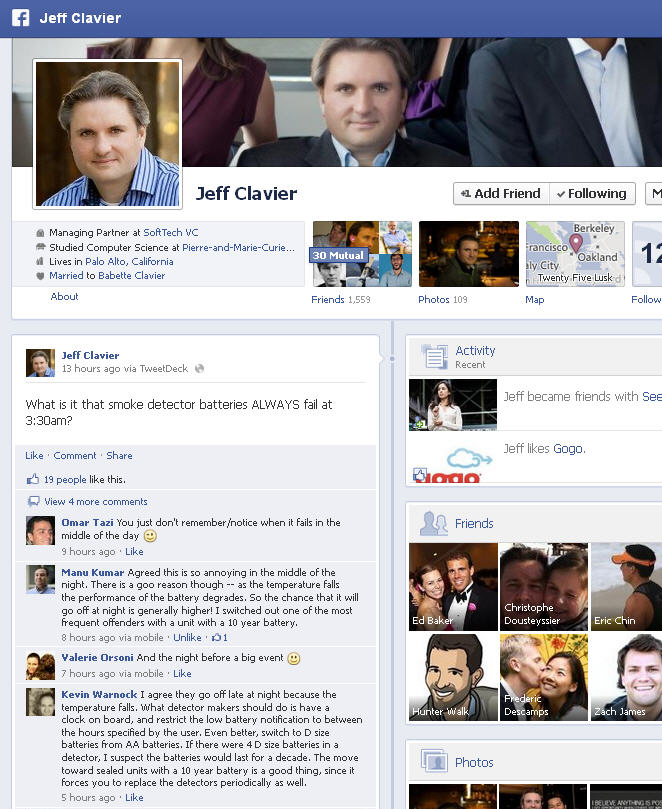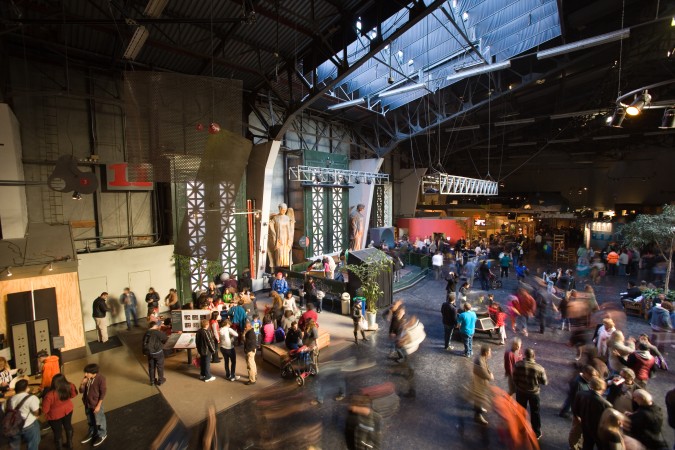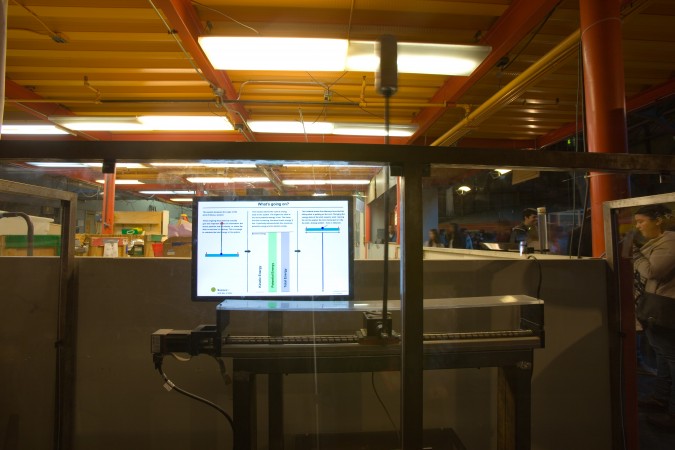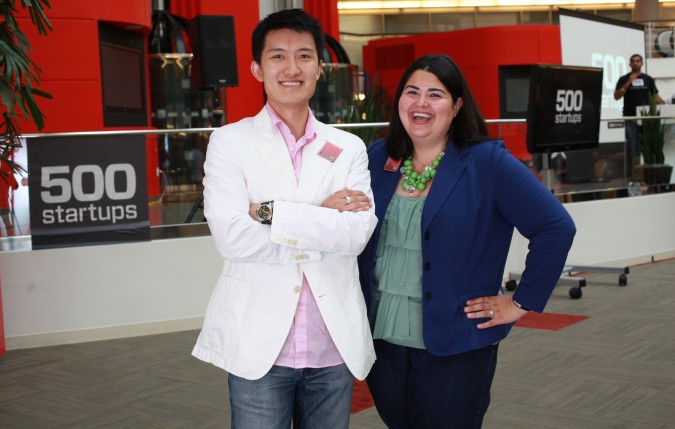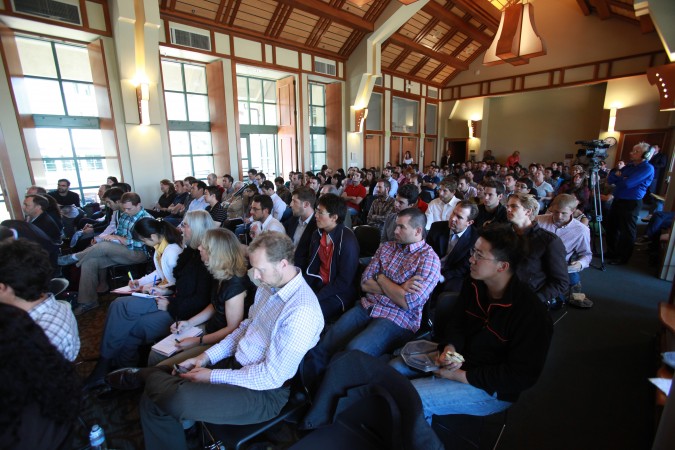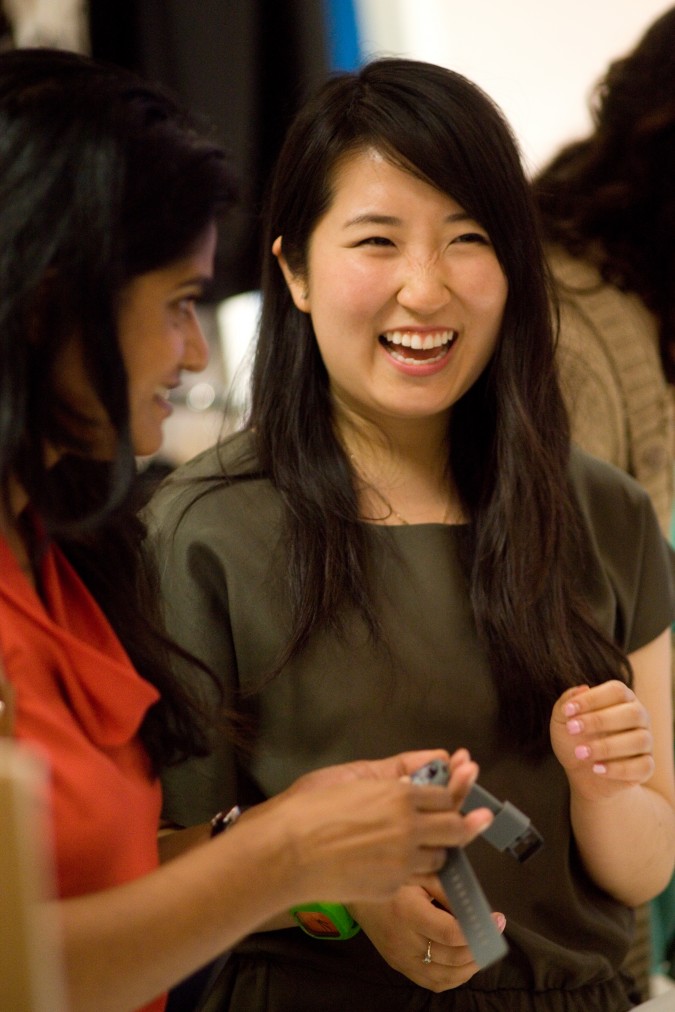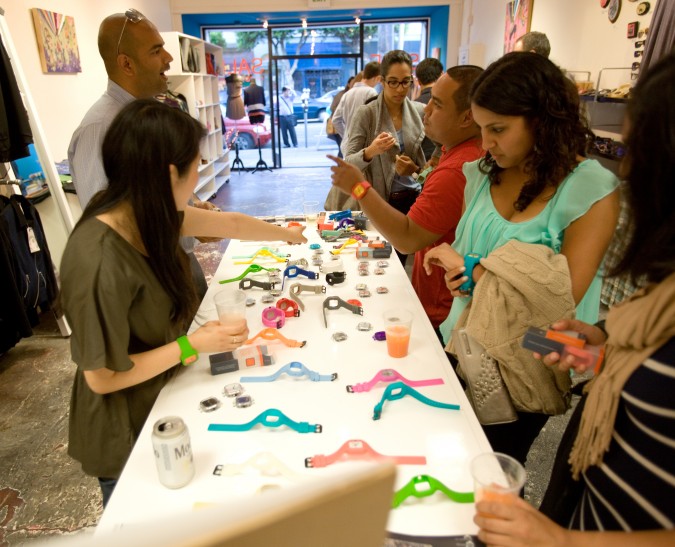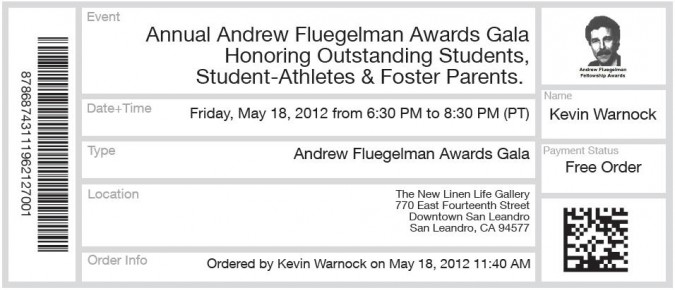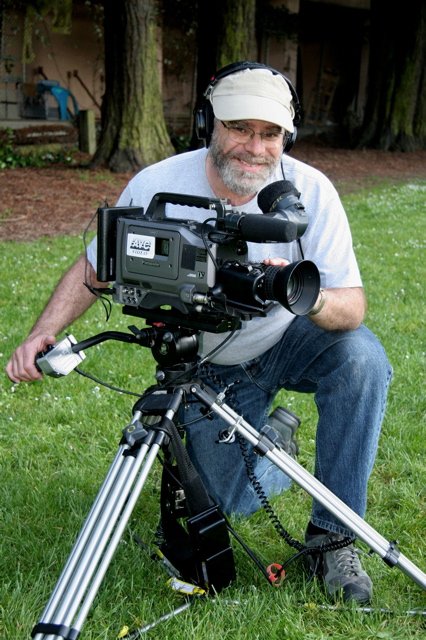Archive for the ‘Technology’ Category
First annual Intel Make it Wearable competition November 2, 2014
On Sunday afternoon, November 2, 2014, I had the pleasure of attending the first annual Intel Make it Wearable to identify exciting technology companies making or proposing to make computers that one wears rather than carries or is stationary.
Make it Wearable is an ambitious new competition, and it’s the most polished and exciting competition I have attended. That’s saying something as I have attended dozens of competitions over the years.
The ten finalists come from China, Chile, the United Kingdom, Germany and the United States. The ideas were wonderfully diverse as you’ll soon learn which helped to keep the event lively and full of surprises. Sex appeal for business competitions is desirable because it helps attract the press and future competitors. I saw reporters from Yahoo and CNet at the event, and even reporters from the Middle East.
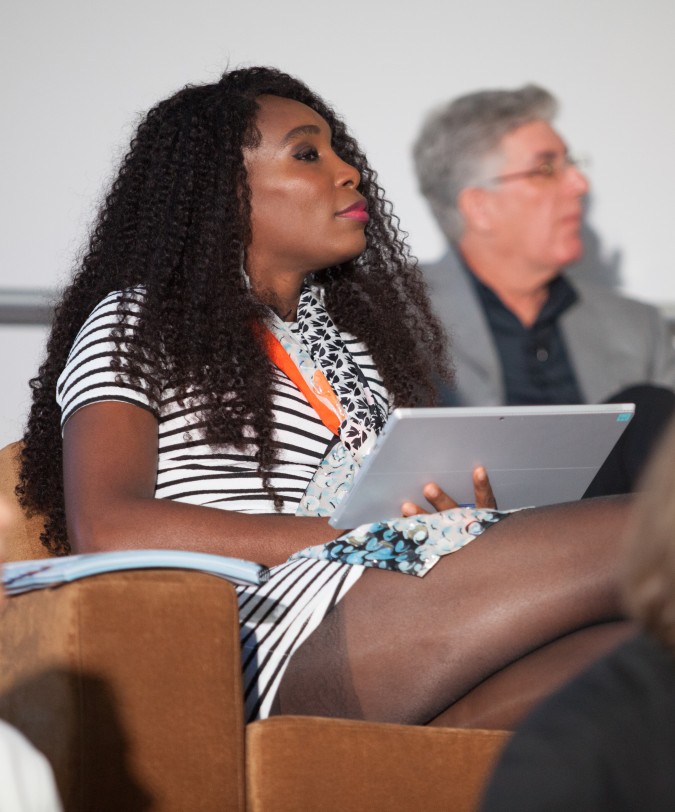
Venus Williams listening to a pitch as a judge for the 2014 Intel Make it Wearable competition on November 2, 2014. Note the Intel chip containing Microsoft Surface Pro tablet computer Williams is holding. The judges voted via these tablets.
Before I jump into the companies, allow me to talk about the event venue, the W Hotel across the street from the Moscone Convention Center in San Francisco, California USA. This was a great choice. The W is very fashionable. It’s not dull and boring like so many big hotels. Intel didn’t just go with a standard W event room though. A designer outfitted the rooms with custom wall textiles that resembled old barn wood and white painted bricks. This theme carried through to the custom printed name tags. There were light sculptures that featured dozens of clear globed incandescent light bulbs dimmed enough you could see the glowing filaments without squinting. These bulbs were dangling down on wires, and the idea was to reference the light bulb over the head to bring up the idea of a fresh new idea being thought up.
There was a disc jockey ever present in the two rooms, though one used her RFID embedded fake fingernails to manipulate a musical track by dipping her fingers in a shallow clear box of water. She got a lot of attention for this, and it was mesmerizing to watch. I learned this was her first gig playing music by playing with water.
The rooms were packed, and the crowd was surprisingly stylish and hip… far, far more hip than the crowds at the business competitions I have attended on college campuses. The only negative is that the event was not open to the public, a big change from previous Intel business competitions I have attended for years in Berkeley, California. I suspect the reason is that this first year was an experiment for Intel, and they wanted to test things out before widening the audience base. I was invited by Intel, a company that has been very kind to me over the years. My last Internet startup was an Intel Capital portfolio company.
My favorite company is Pro Glove, out of Germany. This team won third place and USD $100,000 in the competition.
Pro Glove makes solutions to improve the accuracy and speed of production factory workers. The company says there are 200 million such workers in the world.
The company sells gloves, sensors and software to process the data returned by the globe embedded sensors. Factories apparently for the first time can see exactly what workers are doing with their hands. If a worker skips a production step, the software can spot the mistake and flash a light on the glove to warn the worker to go back and complete the step. The glove analytics software can even tell where the worker is standing in the factory, so if they are walking around needlessly to fetch tools, the manager can spot that an perhaps move the tools closer to the worker to save walking time.
Pro Glove said that for BMW, each second saved on a repetitive task making a car translates into USD $7,500 per year savings for BMW, so having analytics about hand movements of production workers strikes me as a must have. Pro Glove cited various return on investment periods for their different use scenarios. Sometimes the system is predicted to pay for itself in a year, and sometimes in just there months.
I can see Pro Glove gloves being a must have in leading edge factories, and I can see room for lots of follow on products that will have high margin, particularly for the software designed to analyze the glove data. I think a large and enduring business can be built, and that is why I give this team my highest vote.
My second favorite team is Open Bionics, out of the United Kingdom. This team won second place in the competition.
Open Bionics proposes to make low cost three dimensionally printed bionic hands for children. The team proposes a price of just USD $2,000, which apparently is shockingly low compared to current bionic hands, which they said can cost up to $100,000 each.
The Open Bionic model is not as durable or as functional as the models costing 50 times more, but the low cost allows families to fit their handless children with a bionic hand multiple times as needed as they grow up. Apparently insurance won’t pay for a new $100,000 bionic hand each year for a growing child, so handless kids just grow up without handless until they stop growing and can get a fully featured metal bionic hand. Open Bionics was not specific about how current costly models are paid for and how often they are replaced, thus I am reading between the lines a bit here in this paragraph.
The Open Bionic team proposes to keep the cost low by not having patients meet with any medical professionals. Instead, the company will send an Apple iPad brand computer tablet with a 3D scanning attachment to the patient by postal mail. The customer will scan their own arm stump and return the iPad to the company. The company then prints out and assembles a hand that will fit the exact stump dimensions of the patient, and the hand will just show up at the customer’s home by common carrier, to be self installed by the customer.
The hands don’t have a wrist joint, but they can open and close by the wearer just thinking the same thoughts handed people think when they want to open or close their fist. There are electrode sensors that are taped to the forearm of the wearer, and the Open Bionic team had the electrodes on his own arm, and could make the bionic hand open and close just by his thoughts controlling his forearm muscles. It was an impressive demo.
I got to play with one of the bionic hands, and I could feel the hand squeezing my hand when activated by a push button ‘demo’ switch.
Open Bionics has the opportunity to dramatically improve the life of handless children. The price proposed frankly seems too low to keep the company afloat, so I worry about their viability. But the price can be adjusted, and since the team won USD $200,000 in this competition, they have some breathing room to figure out both their technology and the business.
My third favorite team is Nixie. This team won the grand prize in the competition — USD $500,000.
Nixie had the most eye popping video demonstration of their product.
Nixie proposes making a tiny drone helicopter that contains a still and video camera. The drone can fold up and wrap around a person’s wrist. With the flick of the wrist, the drone can be unfolded and then can start up and take flight away from the wearer. Once at a suitable elevation and distance, the camera can face the use and take a picture or start recording. Once done, the drone will fly back to the user and turn off.
Nixie sees itself as a competitor to Go Pro and similar action cameras. Eventually Nixie says they want to compete with normal point and shoot digital cameras.
I held a prototype Nixie drone in my hand, and it is cute. However, it looks impossibly fragile and totally unsuited to wearing while rock climbing, the stated first market Nixie envisions. I can see the drone simply falling off the wrist and falling on someones head below.
But I am happy Nixie won first place in this competition. The idea I think will wow many observers, and it will help brand the competition as one where really cool consumer products can be born and launched. That’s good for Intel and good for the competition.
But I think Nixie won by making the drone wearable as a way to be eligible to compete in this competition. In the absence of the competition, I think the product would have taken a different form. If I were rock climbing, I would want the drone in a protected case that I could easily open and access when the time was right for taking pictures.
Nixie is likely to be costly to start. I can see it costing USD $1,000 to early rock climbing adopters. I think they will find customers even at this price.
I don’t think there are strings attached to the Intel half million dollar prize, so I think that Nixie is welcome to ditch the wearable aspect in favor of practicality. I encourage them to go that route, even though it may secretly irritate Intel.
I admire Nixie for getting a non dilutive $500K to pursue their photography drone. This kind of thinking is the hallmark of successful entrepreneurs — tailoring an offering for the market at hand. Intel was the customer, and Nixie gave Intel a product it asked for. And Intel will be proud of Nixie even if they just become a successful photography drone company.
I can also imagine ways to make a Nixie both wearable and very unlikely to get damaged during arduous climbing. Just put it into a head mounted hard case inside a custom helmet. When the time comes, the helmet wearer could command the helmet to open and for the drone to take off from there. This could even be voice activated via a helmet mounted microphone.
Sadly, I don’t have time right now to finish this post. My grandmother is turning 103 years old December 12, 2014, and I have a project I have to finish by then as I promised her I would take it to show her. I have already spent three days on this Make it Wearable competition, and I need to get back to my regular life. I have a lot more pictures to post, and I want to tell you about the seven other companies, which also are very interesting.
ShoppinPal.com smart phone app from Fermyon, Inc. improves the brick and mortar retail shopping experience for both buyers and sellers
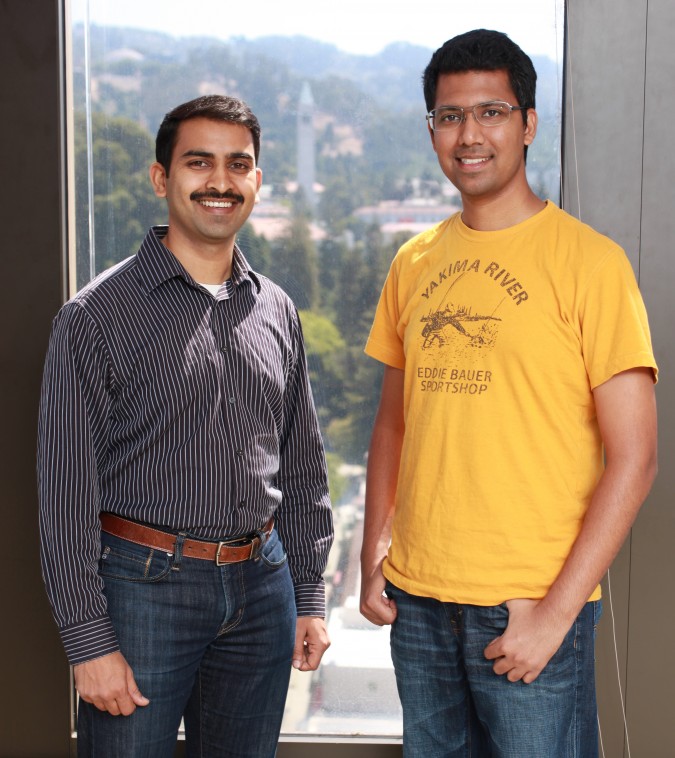
Cofounders of ShoppinPal.com - Sriram Subramanian, CEO, and Pulkit Singhal, CTO. July 26, 2013. Photograph taken at University of California Berkeley Skydeck accelerator, on the top floor of the tallest building in Berkeley, California. That clock tower in the background is on the UC Berkeley campus. Photo by Kevin Warnock.
Fermyon, Inc. is the company behind the impressive ShoppinPal smart phone application that improves the retail brick and mortar retail shopping experience for both buyers and sellers.
On Friday, July 26, 2013, I met with Sriram Subramanian, Chief Executive Officer, 34, and Pulkit Singhal, Chief Technical Officer, 29, the co-founders of Fermyon.
Retailers complain about people treating their physical stores as free showrooms for consumers to touch and evaluate items they will then actually buy online, frequently from giant Amazon. The retailer I suspect feels cheated by these people since they received something valuable, but didn’t make a purchase from the store to compensate the store for their efforts.
Consumers like mobile shopping apps like the one Amazon gives its customers. Smart phone shopping apps let people look up specifications and customer reviews to help them make smarter purchasing decisions. I don’t see shopping apps disappearing, since they offer such compelling value to consumers.
Retailers with physical stores could of course create their own smart phone applications that mimic those from huge online merchants, but it’s mostly larger chain stores that do, because writing a shopping application is difficult and costly.
That’s where ShoppinPal comes in.
ShoppinPal is a service that retailers pay money for — 3% of sales for retailers with over USD $5,000 in monthly ShoppinPal sales, or $49.00 + 3% of sales for retailers that sell less than $5,000 a month through ShoppinPal. This strikes me as assertive pricing, but if it works, Fermyon will be in a position arguably even better than Visa and Mastercard, because Fermyon is not taking any fraud or refusal to pay risk that I can see. On the other hand, no small retailer could hope to deploy a system like ShoppinPal by developing the system itself, and showrooming is a looming problem that likely is motivating retailers to take defensive action.
Shoppers use the service for free.
The retailer gets access to a custom branded application its customers can install on their own phones. In addition, the retailer gets access to an online management console that shows what customers are buying, among many other statistics. Since buyers provide their email address when they install the smart phone app, the store can easily send them custom messages.
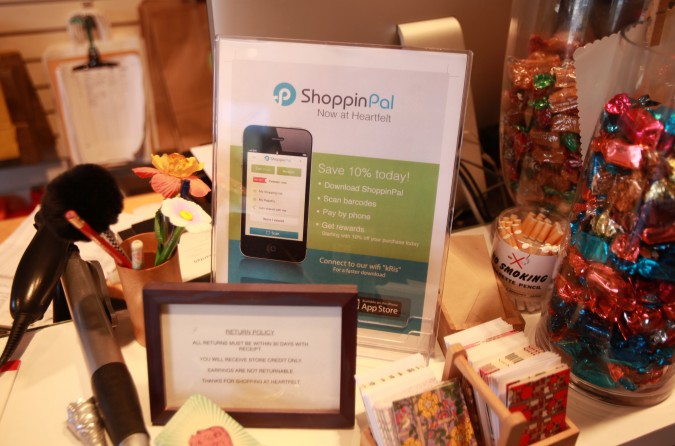
ShoppinPal app display at Heartfelt gift store at 436 Cortland Avenue, San Francisco, California, USA, August 1, 2013. Photo by Kevin Warnock.
For example, if a potential buyer uses the smart phone app to add several items to their ‘wish list’ the store will know about that and can gently remind the potential buyer to return to the store to buy the items. Buyers can be especially enticed to return by being sent discount codes that buyers can use to receive the items at a lower price. Buyers can even opt to have the items delivered to them, offering the convenience of online shopping to the offline world.
I like ShoppinPal. The small team of two co-founders and three staff have put together an offering that appears to come from a larger entity that has raised far more than the modest USD $120,000 in outside capital that Fermyon has taken in.
Buyer engagement potentially starts moments after walking through the door of a shop. One can ‘check in’ to the ShoppinPal app, like one ‘checks in’ on Facebook. The check in alerts store management that the buyer was present.
Next the customer can use the camera on their smart phone to scan the bar code on items they are interested in. The app recognizes the bar code and pulls up that product. The app can, at the option of the retailer, show customers recommendations for other items they may like in their store.
For new retailers, the ShoppinPal cloud based software taps into the retailers’ point of sale cash register system and reviews the receipts for the prior six months of sales. The software sees that people purchased certain items during the same transaction, and uses that set data to recommend that future purchasers also consider such grouped purchases.
CTO Singhal asked current retailers using their system to try the recommendation engine, and those queried marveled at how the recommendations matched with their memory of what many past customers had bought together.
The ShoppinPal app and the website are both beautiful – spare, elegant and clean. The management console is by Mixpanel, a separate company ShoppinPal pays to provide that service.
Sellers can add various incentives for shoppers to buy more items. For example, a discount can be applied after a certain number of purchases. Thus, a coffee shop could automate the ‘buy 10, get 1 free’ paper punch card that still is in use, and was in use at the tea shop where I met with Singhal and Subramanian.
That tea shop in fact allowed customers to store their paper cards in a physical file system on the counter out for the public to access. I marveled the tea shop would put such sensitive information out on public display, because a competitor could surreptitiously copy down a list of the shop’s best and most loyal customers. With quality video cameras in every smart phone, someone could just pretend they were looking for their card while capturing video of every card the thief perused. An electronic loyalty system like that included in ShoppinPal reduces the risk a customer list can fall into the hands of an outsider or an employee that should not have that information.
Inside ShoppinPal, there is not only a wish list, but a gift registry, which should encourage others to buy at a retailer the others may not even be aware of when the items are added to the registry.
ShoppinPal communicates via application programming interfaces to two point of sale cash register systems — Lightspeed Retail and Vend. ShoppinPal hands off to the cash register the precision task of calculating sales tax, sidestepping a thorny problem, since there are thousands of sales tax jurisdictions.
As a customer walks around a store, as they pick up items and place them in their physical shopping cart or basket, they can click ‘add to cart’ within the mobile app. This gives a running total of their planned purchases, and when the customer is ready to pay, they can buy directly from the app, which will display a receipt on screen the customer can show to store staff as they pass through the exit.
This pay within the app feature over time will let retailers hire fewer checkout clerks. The pay within the app feature can be turned off by the retailer that prefers customers visit a cash register to physically run their credit cards through a credit card terminal.
Whether the purchase is paid for in app or at a retailer’s register, the ShoppinPal management console keeps track of all the buyers’ purchases, and makes the purchase history available to the customer, which in my mind is a great perk for the customer. When I shop at Lowes and HomeDepot, I use their loyalty cards mostly because their systems email me a copy of my receipt within minutes after a purchase, which makes my life easier at income tax time.
The sexiest feature of the mobile app is a feature that adds fun to getting a discount. Instead of just writing out ‘you get a discount’ the app presents a silvery gray patch that looks just like the silvery patches covering the digits on lottery tickets. You have to ‘scratch off’ the patch with your finger, and as you rub the screen with your finger, the silvery ‘material’ under your finger vanishes. The effect was startlingly captivating such that I believe a tiny company could be formed just to advance this feature inside other unrelated products from other companies.
ShoppinPal is still an early stage venture. The company was incorporated in January, 2011, but work didn’t really accelerate until CEO Subramanian completed his MBA in June, 2012, last year.
Fermyon has signed up four customers, all via resellers that have agreed to carry their product. I view it as a positive sign that resellers are promoting their product while the company is still so young, for resellers have to be particularly careful to not damage their reputations.
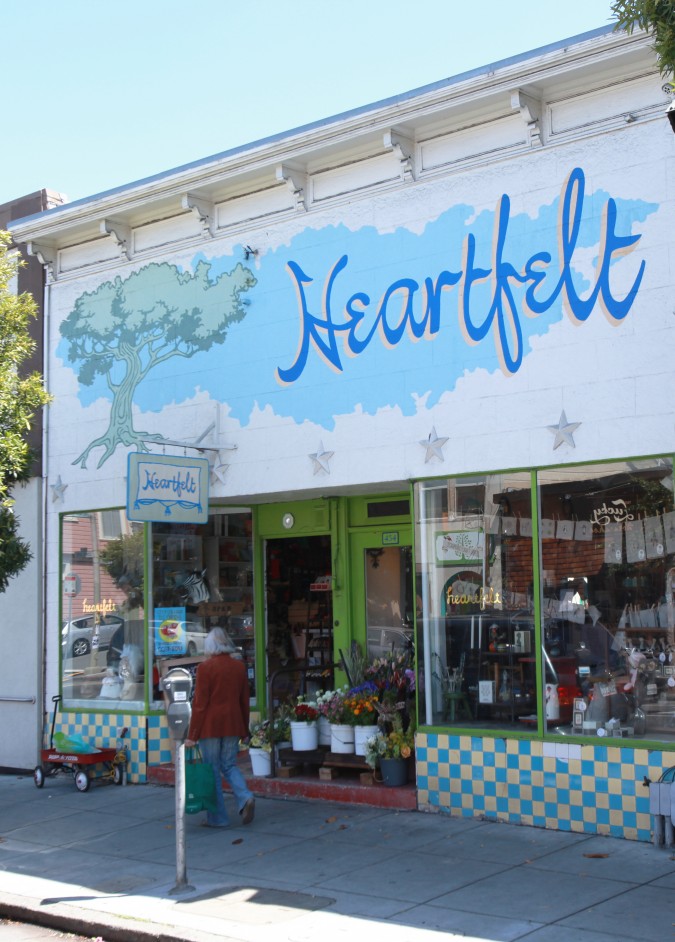
Exterior of Heartfelt gift store at 436 Cortland Avenue, San Francisco, California, USA, August 1, 2013. Photo by Kevin Warnock.
ShoppinPal’s customers are Harney & Sons in New York City, Heartfelt in San Francisco, Isha USA in Tennessee and Marthas Vineyard Glassworks in Massachussets, all in the United States. The Isha implementation is the most demanding, because the organization runs events that draw about 1,000 people twenty times or so per year, so the transaction volumes spike tremendously during events and subside the rest of the year.

Interior of Heartfelt gift store at 436 Cortland Avenue, San Francisco, California, USA, August 1, 2013. Photo by Kevin Warnock.
I live in San Francisco, so I decided to install the ShoppinPal app on my Apple iPhone 5 and visit Fermyon’s customer Heartfelt, a charming and totally adorable gift shop in the Bernal Heights neighborhood. This single store business doesn’t sell items that people are likely to evaluate and then order online from a giant website. But the Heartfelt is the kind of place that I think could benefit from the loyalty, gift registry and wish list features in ShoppinPal. The store also I suspect prides itself on having just the right gift, as there appear to be over 10,000 different items for sale inside this small store. As I was browsing around, I found half a dozen items I wanted to buy, and I am not even looking for gifts right now.

Jewelry for sale at Heartfelt gift store at 436 Cortland Avenue, San Francisco, California, USA, August 1, 2013. Photo by Kevin Warnock.
As soon as you check in, a horizontal red line starts sweeping up and down the phone display. The indicates the phone is looking for a bar code to recognize. I created a video of the ShoppinPal experience from checking in to just before payment. I have embedded the video into this post. The video is a bit shaky because I had to hold my large camera in one hand, and operate the app with my other hand, and since the phone was so close, the depth of field was shallow. But the video does show faithfully what the app does.
As soon as the app finds a bar code, it goes into search mode where it’s communicating with the cash register computer to find the item. This takes about two to six seconds. Then the item shows up in your shopping cart. From there it is confusing what to do next, since there is no ‘checkout’ or ‘buy now’ button. Instead, to continue shopping, you are to press the button in the upper left labeled ‘heartfelt,’ the name of the store. This should be labeled ‘back’ or ‘continue shopping.’ There is a button in the upper right called ‘cart.’ I didn’t try that button, but I assume that button takes you to the shopping cart from where one can checkout.
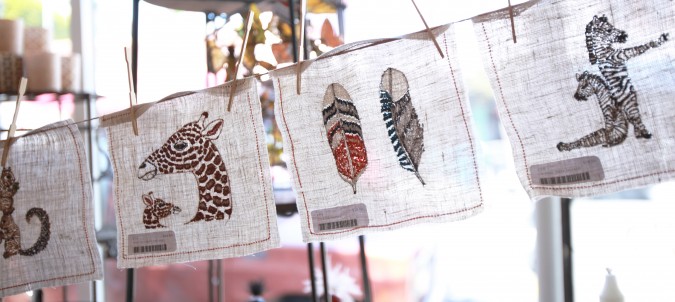
Textiles for sale at Heartfelt gift store at 436 Cortland Avenue, San Francisco, California, USA, August 1, 2013. Photo by Kevin Warnock.
I scratched off the panel as invited, and I got a 10% discount. I was given the chance to pay via credit card or PayPal, the payment service from auction giant EBay. I bought a lightweight wallet made from Tyvek, and I paid via PayPal. The process was quick and efficient, but my receipt listed my discount as $0.00 even though the 10% discount had been correctly applied to the total. I understand that ShoppinPal was only recently installed at Heartfelt, so I expect there to be small glitches to be worked out. For such an early stage yet ambitious application, ShoppinPal performed well.
As you might imagine, ShoppinPal has big dreams and has had sales meetings with huge brands that are household names throughout the US. I suspect that after they build their credibility with smaller retailers for the following months that they will land a national retailer.
ShoppinPal participated in 2012 in the Silicon Valley Bank Seed Showcase, a pitch event to investors for Silicon Valley Bank clients. Silicon Valley Bank is widely considered one of the most important banks in Silicon Valley for startups that aspire to or have raised venture capital investment. You can watch CEO Subramanian pitch on stage and then watch him later that day be interviewed by Carrie Walsh, Managing Director II, ESG, Silicon Valley Bank.
I could find no direct competitors to Fermyon.
The closest offering appears to be CardFree, which automates via a smart phone app some of the tasks that ShoppinPal automates, like payment and loyalty. But CardFree omits the ability to scan the barcode of products to bring up specifications and Amazon.com like product recommendations, two of the most compelling features of ShoppinPal, in my mind.
Another company that does part of what ShoppinPal does is CardStar from Constant Contact. CardStar appears to be a smart phone app just for storing and using loyalty cards from multiple retailers, so your physical wallet doesn’t burst from storing too many physical cards, like mine is threatening to do.
Another loyalty card company is BellyCard, which appears to be similar to CardStar.
Finally, there is a smart phone payment app called AisleBuyer, which lets in store purchasers pay via their smart phone. This company was acquired by Intuit in 2012.
See what former CNET Editor at Large Rafe Neeleman had to say about ShoppinPal in 2012.
The company’s name Fermyon is a play on the particle physics term Fermion. The definition of the Fermion is better left to the article on Wikipedia I just referenced.
I took the picture of Subramanian and Singhal that accompanies this post with my Canon 5D Mark II camera, my Canon 50mm f:2.5 macro lens and my Paul C. Buff Einstein studio flash unit.
The location of the photograph is the Skydeck accelerator run by University of California Berkeley. Jeff Burton is the Executive Director of Skydeck, and Burton encourages me to write about the UC Berkeley affiliated companies that the accelerator houses in its exceptionally glorious 10,000+ square feet of penthouse office space. If you look out the window in the center of the picture, you will see the clock tower that serves as the focal point of the UC Berkeley campus. ShoppinPal is headquartered at Skydeck, but this is not an indicator that the team is reckless with its finances. To the contrary, it’s an indicator that the team is careful with its money since the company’s office space is provided for free by the University of California, from where Subramanian earned his Masters of Business Administration graduate degree. Skydeck gives free office space to only the companies it deems most likely to succeed.
I became aware of Subramanian over the last year because we both attend monthly Cal Founders meetings, which are designed to help founders and mentors be more successful in business. Subramanian and I are more acquaintances than friends since we’ve only met and spoken a handful of times. He learned of this blog and asked if I would write about his venture, and I agreed because I had become intrigued when he had introduced his company during the roundtable discussions at Cal Founders meetings. I disclose the circumstances of how we met to deflect any appearance of bias due to my already knowing Subramanian.
Smoke, fire and carbon monoxide detectors should chirp to signal low battery condition only during waking hours – here is how
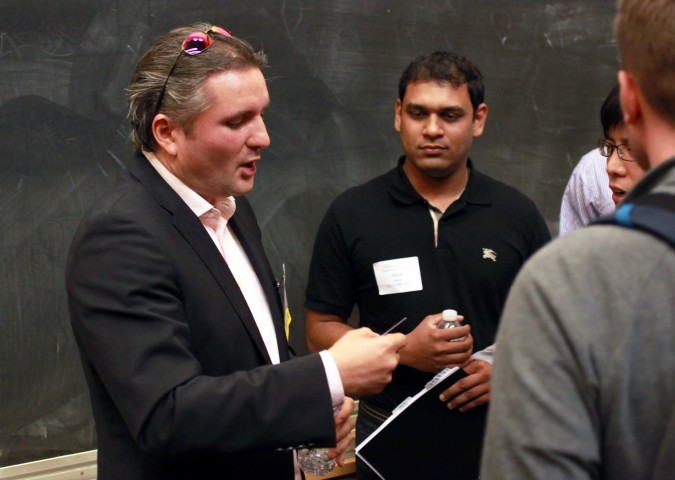
Jeff Clavier, left, August 30, 2012, at Berkeley Entrepreneurs Forum at University of California Berkeley
I have learned that smoke and fire detectors almost always signal low battery condition in the early morning between midnight and five o’clock. This wakes me up and forces me to replace batteries when I am sleepy. I suspect many people don’t have spare batteries always on hand like I do, and simply take the batteries out until they can go to the store. This leaves the premises less well protected, and I suspect fires have started during this period and that people have died.
The fix is so simple I can’t believe I only thought of it today.
Simply include a clock in all battery operated smoke, fire and carbon monoxide detectors. Have this clock powered by its own battery that can last a decade or more. Set this clock at the factory for the part of the world where the detectors will be sold. The low battery circuitry should consult this on board clock, and should suppress the chirping ‘low battery’ notification during typical sleeping hours, say from 10pm to 8am. The chirping can resume at 8am each day until the batteries are replaced. Alarms typically will chirp for months before they run out of power entirely, so the delay in chirping during the night will not cause a significant safety issue.
The clock should be user resettable so the detector can be moved between time zones by the buyer, or set to accommodate unusual sleep schedules.
I suspect the clock I am proposing costs no more than USD $.50 in bulk, and the feature that it will enable can be promoted to boost sales. I suspect such a detector will sell well because I suspect everyone with a detector has been awakened by their chirping.
Chirping during waking hours is likely to be a measurable advance in fire and poisoning safety, since awake and alert people are less likely to make mistakes, like removing the batteries or putting in replacement batteries backwards.
While the circuit designers are at it, they should program the detectors to keep track of the passing years and notify the user when the detector has reached its end of life, around ten years after manufacture. I am sure there are millions of ‘expired’ detectors still in use because people forget when to replace them.
This is my second post on how to improve detectors. My first post Smoke detectors should send activation warnings via text messages via Wi-Fi I wrote July 23, 2011.
I believe detectors chirp now early in the morning because batteries deliver less power when cold, and in many homes the temperature drops lowest early in the morning. Here’s a post by The San Diego Real Estate Inspection Company that agrees with me.
Thank you to SoftTech VC venture capitalist Jeff Clavier for sparking my imagination today to think up this fix. Clavier asked on Facebook this morning why detectors report low batteries exclusively at 3:30am. It’s then that I thought of including an internal clock to solve the problem. I posted my suggestion in a comment on Clavier’s Facebook Wall, and then decided to write this post to formalize my suggestion, with the hope the idea gets discovered and implemented.
If this idea makes money for you or your company, please send me an industry average royalty for using this, out of the goodness of your heart. I am guessing that will amount to about USD $.05 per detector, but that could result in my getting ever more wealthy over time given every residence on Earth should have multiple detectors forever. Thank you!
I will not patent this so it’s now in the public domain if it hasn’t already been patented, which is not unlikely given how simple the idea is. I could quickly find no mention of this idea after performing a Google search for this idea.
I wrote about Jeff Clavier last year, and I took the picture of him that accompanies this post. Clavier speaks colorfully. My favorite quote from when I saw him speak August 30, 2012?
“I passed on airbnb that some showed me when it was called air bed and breakfast and I said ‘air bed and breakfast… are you f—ing kidding me?”
My preference is that the world move quickly towards hard wired sealed detectors that have backup batteries that will last ten years. It also seems that non hard wired detectors should have solar cells like calculators and watches, to keep the batteries from having to drain themselves so quickly.
My clock idea I present here is still relevant to such detectors, since I would prefer to learn the detector needs replacing while I am awake and likely to buy a new one at once.
Consumers should be permitted to voice record conversations they have with companies
To my knowledge, in the United States it is illegal to record conversations unless you have permission of the parties you’re recording. I believe the rules are more lax in some jurisdictions, but those exceptions are not that helpful if one wants to record a phone conversation with a company representative, because call centers are so dispersed over the planet. A representative could be anywhere.
I think United States Federal law should be changed to specifically permit consumers to record conversations they have with employees and other representatives of companies. Nothing stops me from asking for permission today, but I have never been granted permission when I have asked, so that’s why the law should be changed.
Companies routinely give themselves the right to record calls, so they should understand why a consumer would also want to have that ability.
I came to my recommendation January 29, 2013, after I had a frustrating conversation that day with Brian G., a supervisor at Godaddy, the Internet domain name giant. Brian’s email address is briang@godaddy.com. Brian refused to give me his last name, citing a Godaddy security policy.
On or around December 14, 2012, I learned a domain I’ve been wanting for a dozen plus years was in ‘redemption.’ This means the prior owner didn’t pay to renew it, so the registrar placed the name into redemption, a kind of holding place for domain names before they are eventually released to the public for purchase.
My heart raced. I was going to finally be able to reacquire the Hotpaper.com domain. I sold the name in 2000. My first reaction was to write to my friend Dan Luis and ask if I could pay the redemption fee to Purple, the company I sold the name to a dozen years ago, so they could retrieve the name from redemption status. This would then give Purple the right to transfer the name to me.
But after I composed the email to Luis, who I have been in touch with as recently as 2012, I decided to run this idea past GoDaddy, which was the registrar for Hotpaper.com.
I told the representative about my connection with Purple and proposed doing what I just outlined. The representative then advised me to not bother, and just sign up for GoDaddy’s Domain Name Backorder service, which cost about USD $20.00 and included a full year of registration. This made the cost for getting the domain about $8.00, which is just 1/10th what it would have cost me to pay Purple to get the domain out of redemption status.
The representative told me that since GoDaddy was the registrar for Hotpaper.com that they would be able to get the domain name for me through their backorder service. He said that if Hotpaper.com had been with another registrar then they would have had to fight to try to get the name. The representative assured me multiple times that in this situation their backorder service was a sure thing. Not once did he even hint that I would be rolling the dice. Had he alerted me that I was speculating, I would have hung up and pursued the sure thing of contacting Luis.
Either Luis would have redeemed the name for Purple to hold on to, or he would have allowed me to redeem it through Purple. Luis would not have ignored me and let the name hit the open market — he’s my friend, and even though we haven’t seen each other in ages, we share a bond, for we both sold our companies to the company that is now Purple. Why am I so sure of this? Luis is the one that keeps our association alive by saying hello to me from time to time, not the other way around. I believe Luis respects me and does not want to upset me, so he would not take an adverse position, especially on something like this that is of no consequence to Purple, since they retired the Hotpaper name around a decade ago.
I would have been fine had Luis redeemed the name and had Purple hold on to it for decades to come. My desire is for the name to not fall into third party hands, so it was great that Purple paid the registration on the name for so long after they stopped using it. I saved over USD $100 over the last decade thanks to the kindness of Purple. Thank you.
I have explained to GoDaddy that their representative promised to get me the Hotpaper.com domain and failed, and to fix this failure they need to buy the domain and give it to me for the backorder fee I paid. This is a case of an employee being insufficiently skilled and trained, and their failure led to this sad result. GoDaddy the company is at fault, I believe. Yes, there may be some fine print somewhere on the GoDaddy website explaining the backorder process is akin to gambling, but GoDaddy’s sales representative negated that fine print.
I believe I was behaving reasonably when I took the word of the GoDaddy representative.
I figured that GoDaddy would have an advantage in ‘catching’ domain names dropping from their registry in the same way that high speed Wall Street traders benefit from extremely close proximity to stock exchange computers, so much so that high speed traders rent space in premium Wall Street colocation space to get faster connection times, since the speed of electricity is only so fast.
I have never bought a domain through a name catching service, so I was not an expert when I placed the order. But I felt the representative I ordered through knew what he was talking about, because he was so articulate, well spoken and because his explanation of why GoDaddy would definitely get the name sounded technically and practically believable.
If I had recorded that conversation, I believe GoDaddy would buy Hotpaper.com on the open market and give it to me for the backorder fee I have already paid. The conversation was so crystal clear and frankly damning that GoDaddy would not want to risk the recording and this story hitting the front page of Reddit, where I predict GoDaddy would have taken a beating from the readers of that news site.
This domain issue is of little importance. I survived a dozen years without the domain, and I’ll be fine without it for the next dozen or three dozen years. I have Hotpaper.net if I ever want to do anything Hotpaper related in the future.
The right for consumers to record calls with businesses, without notice, however, is a right US residents should have. There are so many business that will only correspond with customers over the phone. All banks I know are like this, and will simply not engage a customer by writing emails or letters back and forth. If you try to send a letter, often you’ll get a letter back asking you to phone. Banks I am sure force business to be conducted by phone because they know there will not be a record the customer can keep and refer to or publicize if the customer is mistreated.
Customers need to be able to believe what they’re told by company representatives, which, sadly, is a bigger and more difficult issue. I appreciate and recognize that I should have independently verified by reading the fine print on the GoDaddy website what the representative told me. I didn’t do it because the representative was so confident and self assured, and because the stakes were not material. Frankly, I’ll save hundreds of dollars over the years by not having to pay to keep the Hotpaper.com domain for myself, so you can even say GoDaddy did me a favor by the failure of their representative to explain how their backorder service works.
Companies should do the right thing by their customers when their representative makes such an obvious and glaring error. If a car dealer sells you a lemon, they’ll have to buy it back from you. If a doctor amputates the wrong limb, they’ll pay you plenty. If a lawyer drops the ball and forgets a filing deadline and you lose your case as a result, she’ll pay you.
Here we have a salesperson that sold me a product by misinforming me about its most important workings — whether intentional or not is irrelevant. This strikes me as fraud, though I am not a lawyer. GoDaddy should fix this apparent fraud by buying the domain and delivering it to me.
While researching this story, I found the website Anti GoDaddy, which collects GoDaddy horror stories from consumers. I posted a screen shot of this site’s home page at the top of this article. Notice the reach of GoDaddy — the embedded advertisement near the top of the page is for GoDaddy.
If this domain had been really important to me, I would have not handled the matter so casually. On a scale of 1 to 10, the Hotpaper.com domain ranks a 0.1. Note that I have not linked to the domain so as to not give traffic to the domain name speculator that ended up acquiring the name. The last time I checked, which was just once, there was a generic page offering to sell the domain.
The US Federal government should allow recording of conversations by consumers with businesses to reduce the harm that comes from currently insufficiently documented conversations. I suspect there are thousands of people that lost their homes in recent years because a bank told them verbally not to worry about their loan modification delays, but then foreclosed anyway. Had those promises been recorded by the consumers, the banks may have not been so quick to make promises they couldn’t respect, and homeowners could have pursued other options with more awareness of their true situations. The ramifications of only the business being able to record conversations are likely widespread and quite substantial, in every field, with every size business. It’s simply not fair to let only one party avail themselves of voice recording technology. Society would not stand for lopsided court reporting during trials, where the transcription was for the benefit of only the defendant or only the plaintiff. Why does society permit injustice with documentation outside the courtroom?
Laws need to change. I don’t know about the laws outside the United States, but I suspect this post applies to most of the planet.
11,750,000.00, not 10,000,000.00
Last week I was doing some research on my first Internet company, Hotpaper.com, Inc. I discovered a report I had never seen before, from PrivCo Media, LLC. According to PrivCo’s report, I sold my company for USD $11,750,000.00, which is more than I knew. The published price was $10M, but I always knew the actual price was technically higher because the acquiring company didn’t cancel the stock options of my employees. I never really found out the exact value of that part of the compensation, since I left the company soon after the deal closed, and I never went hunting for the number.
The final day at The Exploratorium science museum at The Palace of Fine Arts in San Francisco, California – January 2, 2013

Palace of Fine Arts about an hour before sunset on January 2, 2013, the final day of operation of The Exploratorium science museum at that location.
Earlier today I took an emotional trip down memory lane by photographing the world famous Exploratorium science museum during its final hour at its building at The Palace of Fine Arts in San Francisco, California USA. On Friday, April 12, 2013, the Exploratorium opens at its new location at Pier 15, on the historic waterfront north of Market Street and near the Ferry Building in San Francisco. Pier 15 is served by historic restored street cars that stop in front, so I predict that many more people will visit, since the original location is rather difficult to access, and parking in particular is a nightmare.
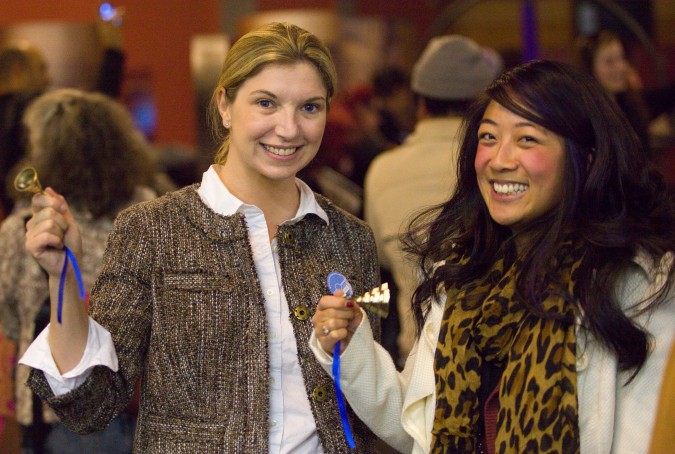
Bell ringers smile as they celebrate the start of a new chapter for the Exploratorium, January 2, 2013
If invited by the Exploratorium staff, for example after they discover this post, I will cover the opening event on this blog, and I will photograph it with the same quality technique I used for the photographs that accompany this post. If not invited, I will wait for a free admission day to visit.
I used my Canon 5D Mark II camera for these pictures. I uploaded the pictures at full camera resolution of 21 megapixels. Click on them to see them at full size. I used a tripod for many of the shots, and since it’s so dark inside the Exploratorium, many of the pictures were made with time exposures of up to 8 seconds. That accounts for the blurred people in some of the shots. I like that the blurring suggests lots of busy activity at the museum, which is definitely true. The tripod shots were taken at ISO 100, so the image quality is outstanding. The handheld shots were taken at ISO settings as high as 6,400, and the quality suffers. I should have brought a flash so that I could have taken more photographs of visitors experiencing the exhibits.
I love and admire The Exploratorium museum above all others. The Exploratorium teaches visitors about the world we all live in, and it does it in such an engaging and fun way that visitors keep coming back, over decades. The exterior wall of the large gift shop was covered with sweet notes from visitors, and these note cards were grouped by decade. Even the 1970s section had over 100 cards on it.
The Exploratorium opened in 1969.
The Exploratorium has exhibits that seed the imagination, so this museum helps human kind progress. I think The Exploratorium is more effective at seeding the imagination than even the traditional great museums of the world such as The Louvre.
I almost missed this special day, and had it not been for the website Funcheap San Francisco which lists free or inexpensive ways to have fun in my favorite city. I subscribe to the site’s Facebook page, and a status update to that page alerted me to the final day I am covering here.
Here below is a sequence of photographs that give you a tour of this large museum space, starting and the front, then moving to the upper deck level, and finally showing the back of the museum from the deck.

View from shortly past the front entrance to the Palace of Fine Arts Exploratorium, January 2, 2013, minutes before closing time.
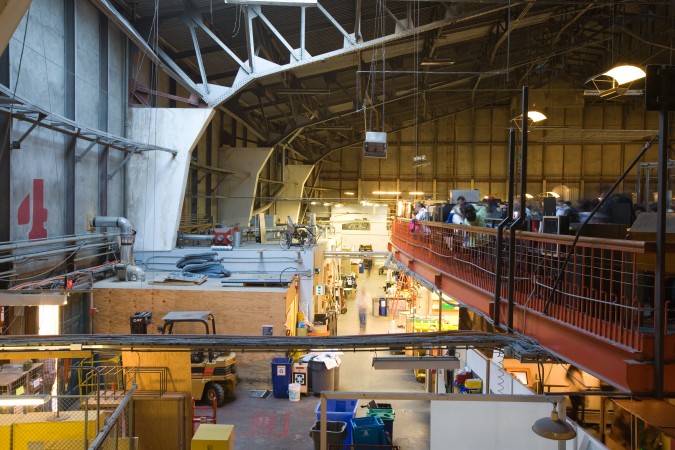
The workshop where the exhibits are built, January 2, 2013. Note that it appears to me that many of the big shop tools have already been removed.
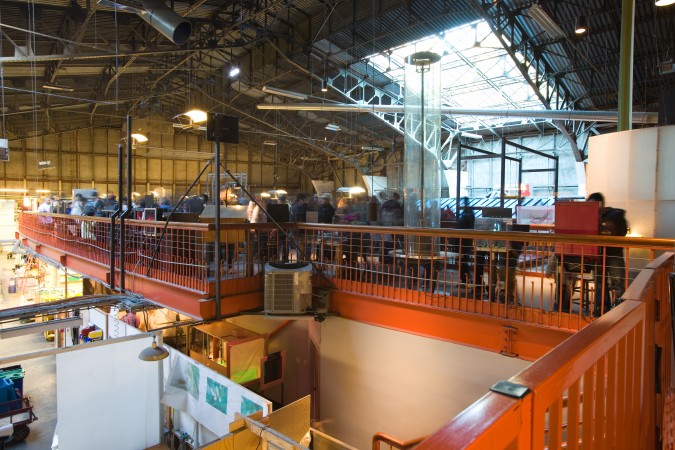
The upper deck that overlooks the workshop area at the Palace of Fine Arts Exploratorium, January 2, 2013.
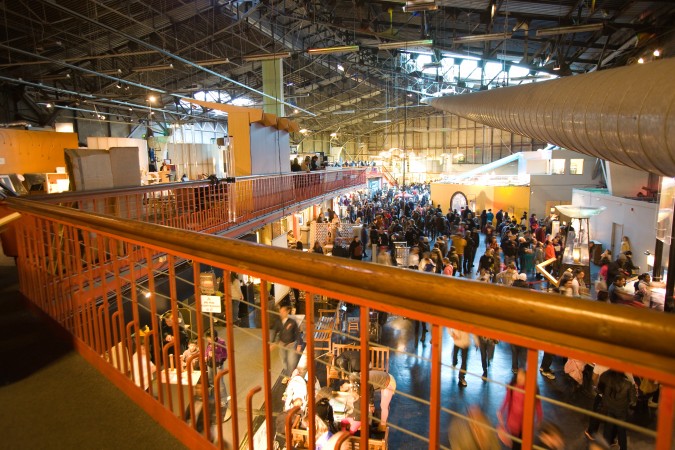
Looking toward the front entrance to the Exploratorium during the final hour of operation at The Palace of Fine Arts, January 2, 2013. Look at the echo chamber pipe in the upper right of the frame.
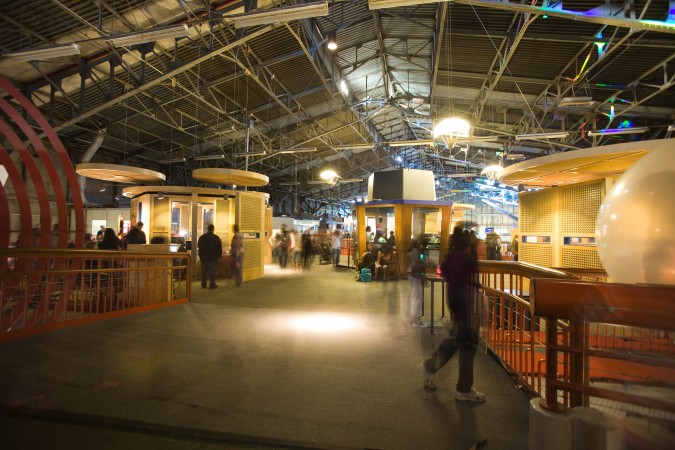
A 6 second long exposure of the upper deck at The Exploratorium on its final day at The Palace of Fine Arts, January 2, 2013

From the upper deck looking toward the back of The Exploratorium at The Palace of Fine Arts, January 2, 2013. Notice how most of the illumination is from the enormous skylights. It's always been dark inside, even when I was in high school. It's a good thing I brought my tripod to allow long time exposures.
Now I will show you some of the exhibits. Note that no admission was charged today, so there were more visitors than normal. I only had one hour to take still pictures and video, so I was rushed.
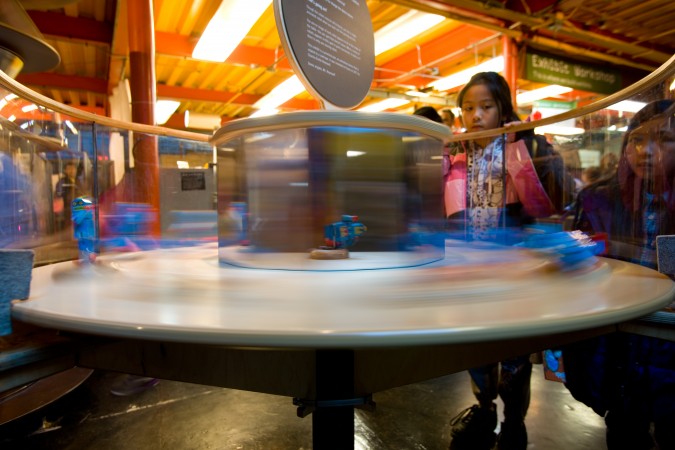
A spinning exhibit with mirrors and toy action figures. When spun, a viewer looking into the mirrors sees an animation of all the figures.
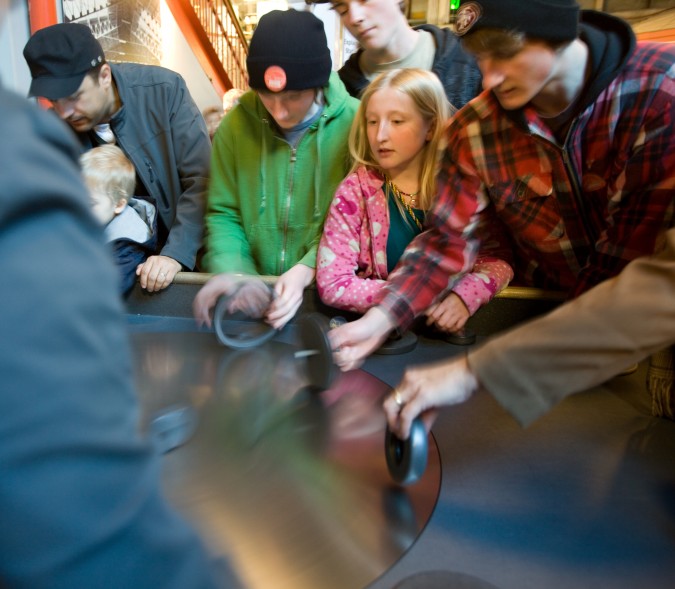
The round disk in the table surface is rotating. Visitors try to place metal wheels onto the surface of the quickly rotating disk. If successful, the wheels roll mostly in place relative to the visitor. I remember this exhibit from my childhood.
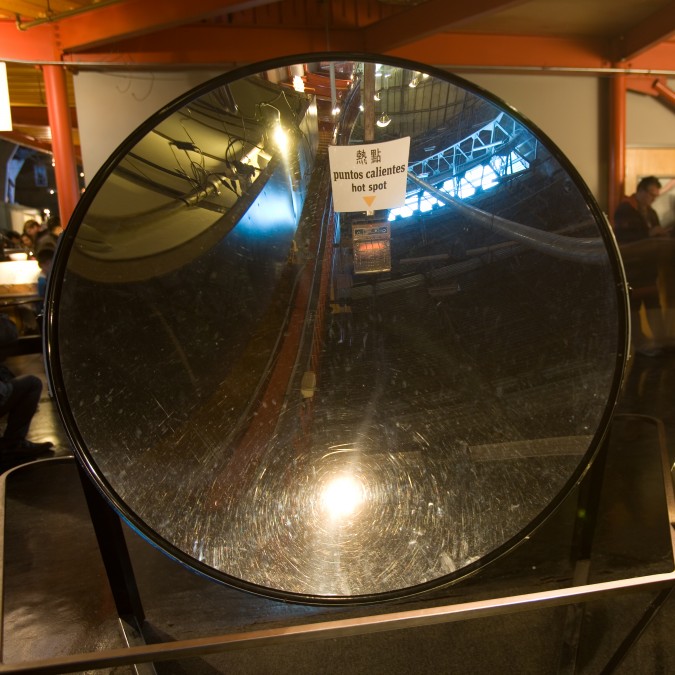
Large parabolic shaped mirror demonstrates that light and heat can be focused to a point. Note electric space heater pictured in the center of the mirror.
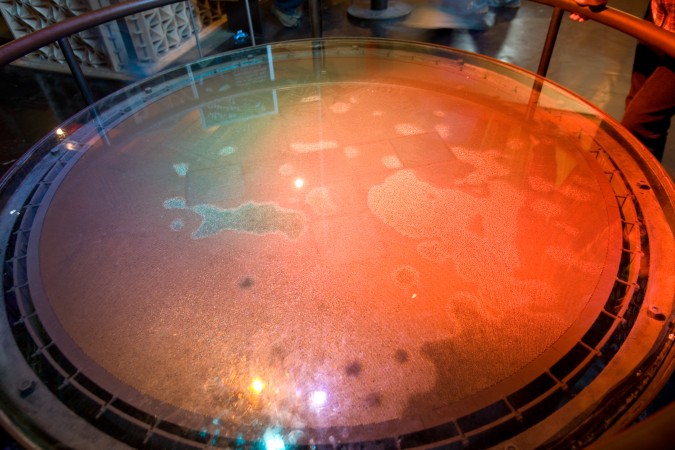
Colorful exhibit at The Exploratorium, January 2, 2013. Sadly, I was so rushed that I didn't learn what is being taught here.
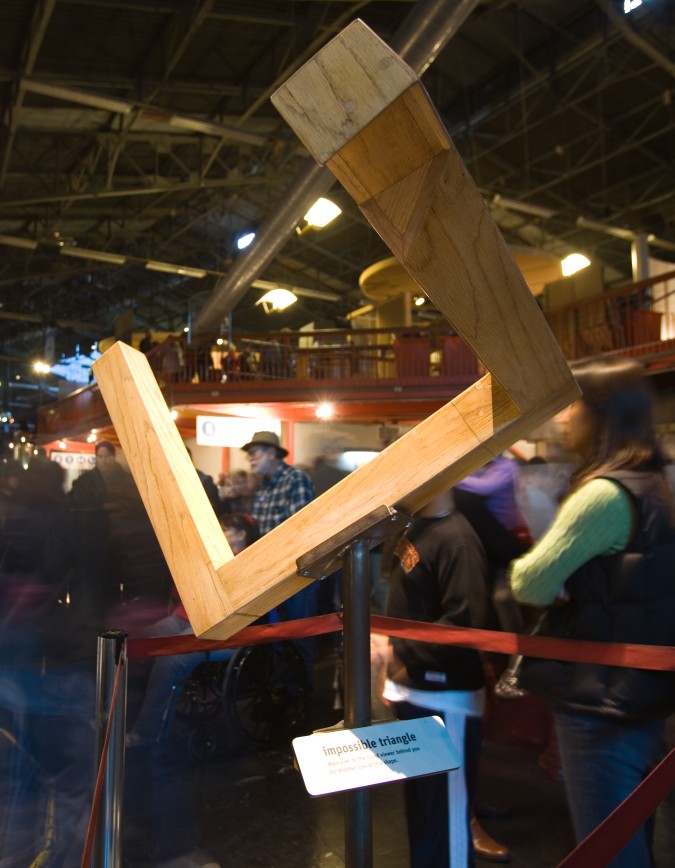
I remember this exhibit from when I was in high school. From a specific vantage point to the right, this looks like a solid triangle of wood. From this angle, it's quite a different shape. Memorable.

I remember this water vortex exhibit from when I was in high school. This plastic cylinder is about a meter across and 2 meters tall... impressive.
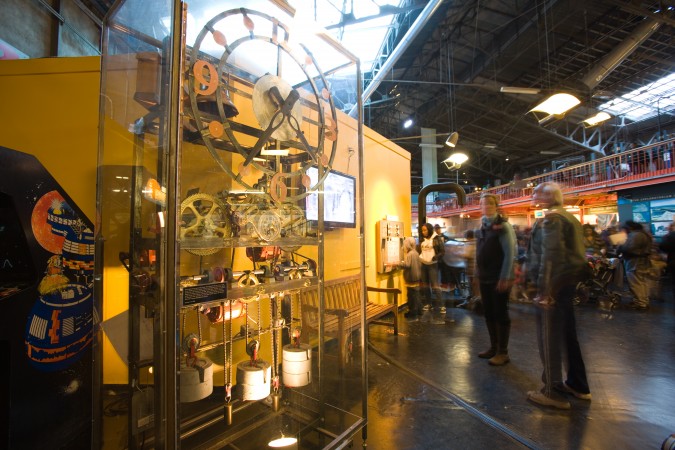
Large mechanical clock powered by energy stored in lifted concrete weights. This shot was taken at 4:35pm, 25 minutes before the Palace of Fine Arts Exploratorium closed forever on January 2, 2013.
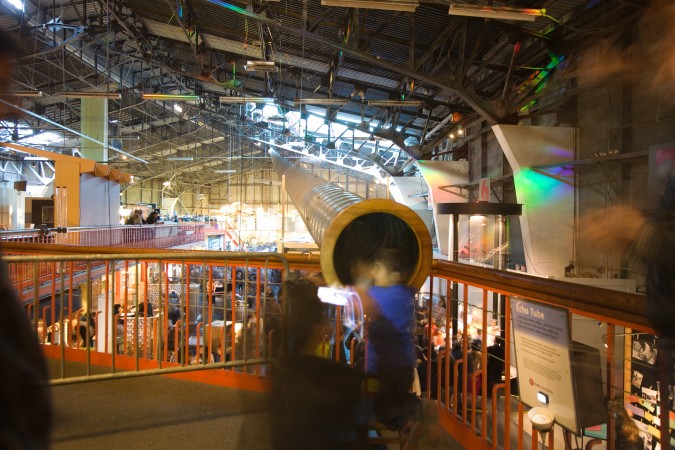
A child clapping into a long echo chamber tube, and listening to hear the sound of his clapping race to the end of the tube and back
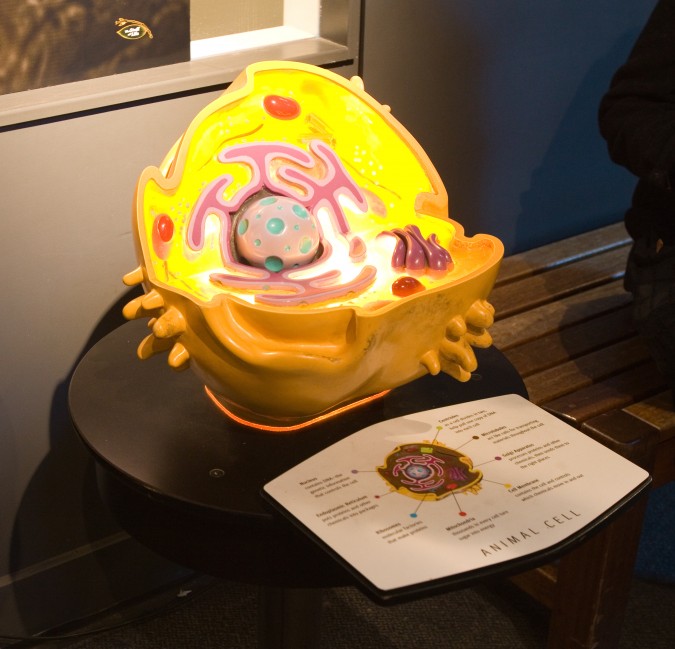
A model of an animal cell at The Exploratorium science museum at The Palace of Fine Arts in San Francisco, California USA, January 2, 2013
As I was leaving, I picked up a free poster advertising the new location for the museum, which will be Pier 15 on the San Francisco waterfront, downtown, near the Ferry Building.
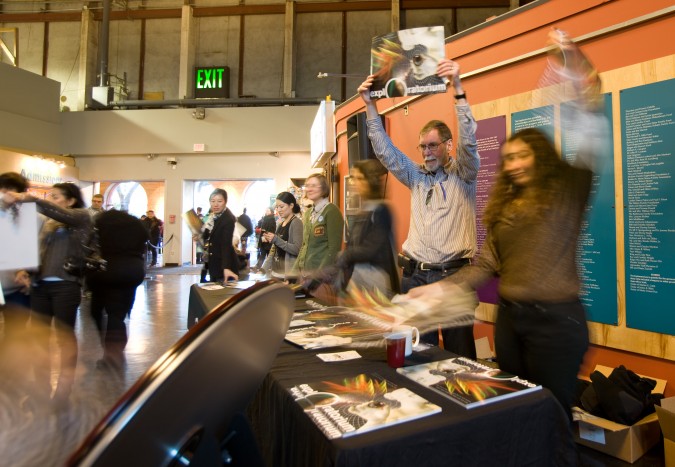
Staff members handing out free promotional posters for the new Exploratorium that will open later this year near the Ferry Building in downtown San Francisco. Picture taken January 2, 2013.
After the gates were closed, there was a private party, with speakers thanking those assembled.

Guests at private party after the closing of The Exploratorium on January 2, 2013 listen to remarks from various speakers over the public address system.
I set up my tripod outside the front door and posed for a self portrait to memorialize this memorable day.
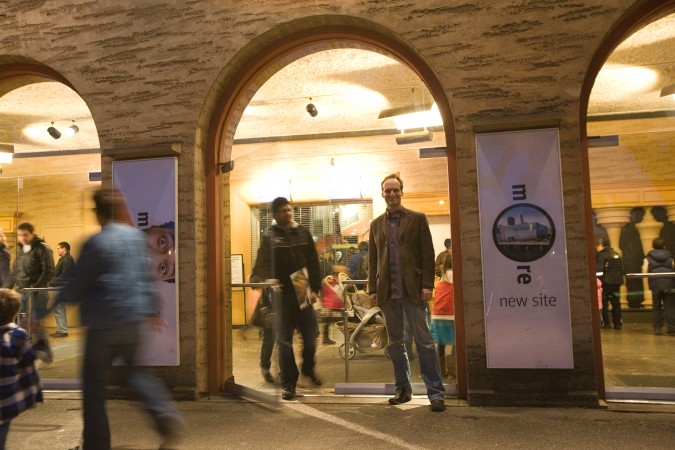
Kevin Warnock, right, stands in front of The Exploratorium at The Palace of Fine Arts in San Francisco on its final day, January 2, 2013. Photograph taken via self timer.
On my way back to my car, which I parked many blocks away, I set up my tripod one last time to take this ‘magic hour’ photograph of The Palace of Fine Arts.

The Palace of Fine Arts shortly after sunset on January 2, 2013, the final day the Exploratorium was open to the public.
Note that the Exploratorium posted a sign at the entrance warning visitors that pictures and video would be captured by many people today, and that some of the material would be published.
I will miss this original location. It’s industrial and gritty and feels authentic. Outside by the adjoining Palace of Fine Arts, the location is truly beautiful. I fear that the new location will be too new, sparkly and flashy, and that the glitz will remove the charm that permeates the original.
Launch party for Apple iPad fashion magazine and shopping app Monogram, at La Boutique l’art et la mode in San Francisco, California
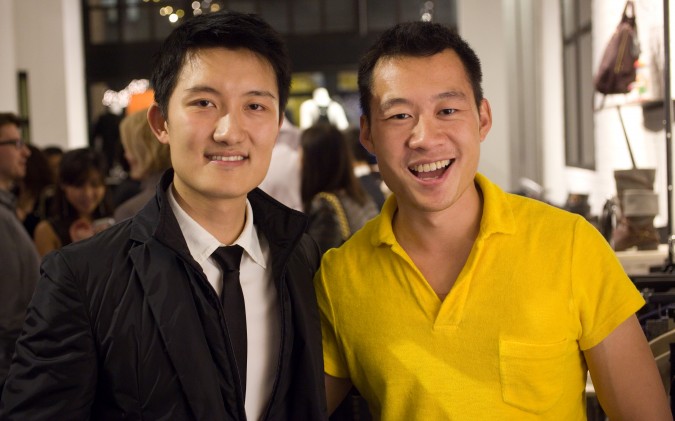
Leo Chen and Justin Kan at Monogram app launch party, 414 Jackson Street, San Francisco, California USA, November 27, 2012.
On Tuesday evening, November 27, 2012, I attended the launch party for a company run by Leo Chen.
Chen runs Fara, Inc., which recently released its first product, an app for the Apple iPad tablet computer.
The application is named Monogram, and that’s how I’ll refer to the company and product for the rest of this post, as the company doesn’t seem to promote the Fara name.
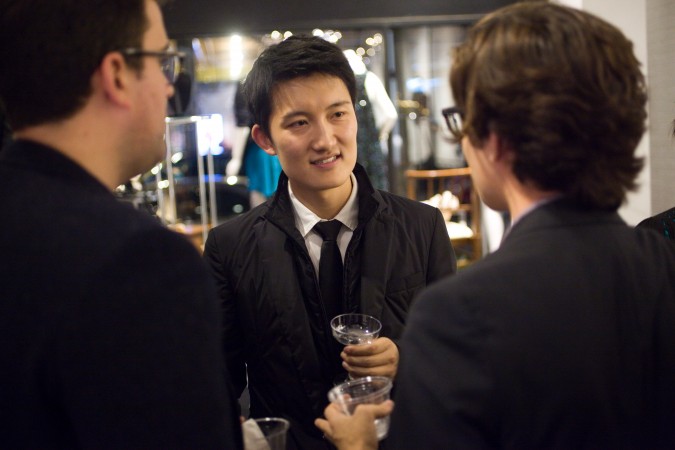
Leo Chen (center) talking with two guests at his launch party for his company's Apple iPad app 'Monogram', November 27, 2012, San Francisco, California USA
I met Chen July 18, 2012 at the Demo Day for the 500 Startups Accelerator program. Monogram was one of the presenting companies. I attended the Demo Day as a blogger so I got to meet all the graduating companies. Thank you to Dave McClure for getting me an invite to Demo Day. McClure is the founding partner of 500 Startups.
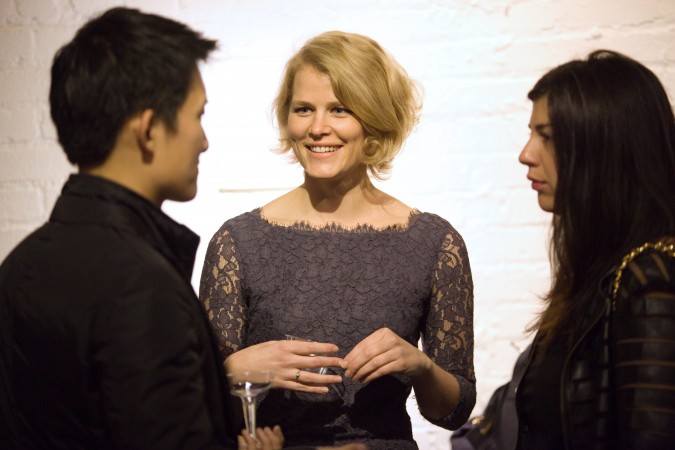
Leo Chen (left), CEO of Fara, Inc., talks with two guests at launch party for Monogram iPad app, November 27, 2012
Chen stood out because he was the most stylishly dressed. See my picture of him I took at Demo Day at the bottom of this post to see his pure white sports coat paired with jeans, a hip wristwatch and a pink shirt. Not many guys can pull off this eclectic look. That Chen can suggests he will have the fashion sense to make the right calls at Monogram, which, when you really study it, is a company that requires good taste to have a chance to thrive.
His app, which he demonstrated to me personally, was sumptuous, glorious and stunning — and it was still unreleased code.

Leo Chen on left talks with guest at Monogram iPad app launch party, November 27, 2012, San Francisco, California USA
I don’t have an Apple iPad, so I have not seen the released version of Monogram. Chen wasn’t showing off the app on his iPad at the party either, so I simply can’t write a review here of the app — sorry!
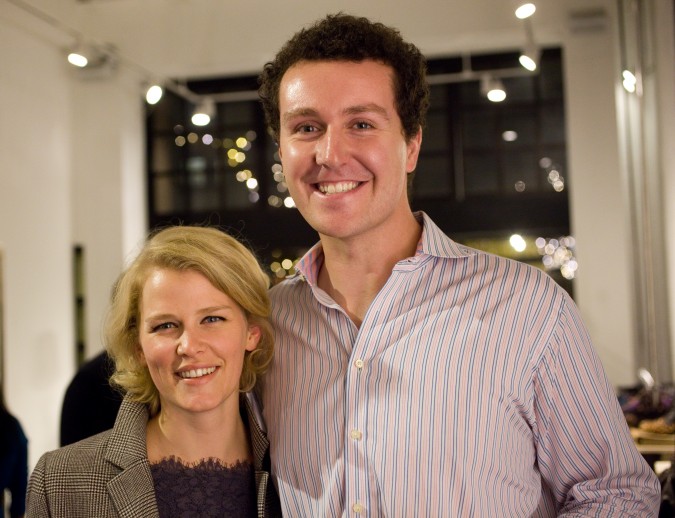
Fergus Hurley (right) at Monogram fashion magazine and shopping iPad app launch party at La Boutique l'Art et la Mode, November 27, 2012, 414 Jackson Street, San Francisco, California USA
The famous TechCrunch technology blog covered Monogram on November 1st, 2012 in an article entitled 500 Startups Alum Monogram Raises $400K More, Launches iPad App To Aggregate All Your Favorite Fashion Brands.

Kristen Slowe, Chief Creative Officer of Fara, Inc., the maker of the Monogram Apple iPad app, and her husband Chris Slowe, Chief Scientist at Hipmunk.
Since I can’t write a review about the Monogram app sight unseen, I’ll give you just the basics. You download the free app from the Apple App Store. You browse through pages of the app as if you’re looking at a fashion magazine. If you see something you want to buy, you can tap on it and get transported to an online retailer that sells that item. You’re presumably transported to precisely that item, not the front page of the retailer’s site. If you buy, Monogram collects an affiliate payment from the retailer, and that’s how Monogram makes money.
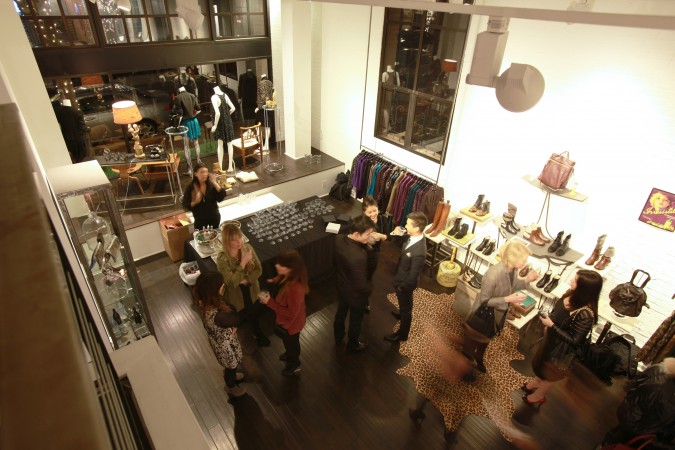
Fara, Inc. launch party for Monogram Apple iPad app at La Boutique l'Art et la Mode, 414 Jackson Street, San Francisco, California, November 27 2012
I met many of the attendees at the Monogram launch party, and I can say that Chen and his team have smart and impressive friends. The venue for the party, La Boutique – L’Art et la Mode, was perfect. Carole Harari, the owner of the boutique, has created a 2,500 square foot oasis that is part women’s clothing boutique, part art gallery, part furniture store and part event space. The women’s fashions for sale are eclectic and desirable.

Fara, Inc. launch party for Monogram iPad app at La Boutique l'Art et la Mode, 414 Jackson Street, San Francisco, California USA, November 27, 2012.
The pop up furniture store on the second level was so photogenic I took an architecture style picture while I was up there to get a shot of the crowd below. La Boutique is so photogenic that I asked Harari for permission to photograph models there.
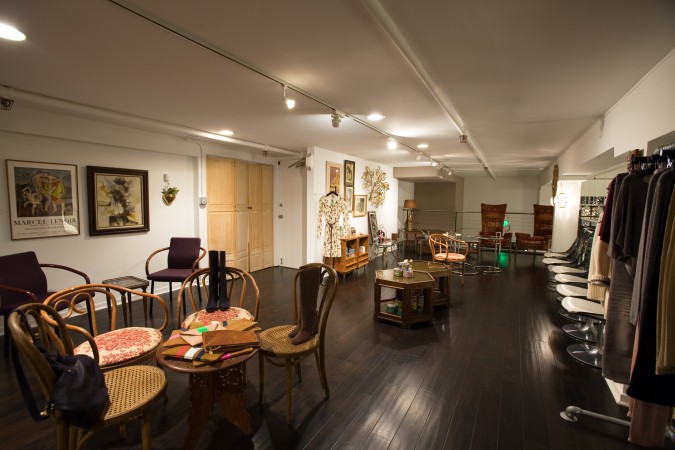
Upper level at La Boutique L'Art et la Mode, 414 Jackson Street, San Francisco, California, USA November 27, 2012.
I met Justin Kan for the second time. I met Kan for the first time — you probably have heard of his as Justin of Justin.tv fame — at a Stirr mixer in Palo Alto, California in about 2008. I spoke with him back then for perhaps 10 minutes, and they were a stressful set of minutes because he had a video camera strapped near his head and wore a backpack with four 3G wireless cards whose bandwidth was combined through software so the laptop in the backpack could broadcast Kan’s every move live to the Internet. This can be done with a smart phone today, but back then live streaming was rare, and my talk with Kan then was the first time I had been live streamed before a meaningful audience.

Justin Kan's Nixon brand watch on his arm, November 27, 2012, San Francisco, California, at Monogram launch party.
On Tuesday, Kan was wearing one of the largest watches I have ever seen, and it was so eye catching I asked to photograph it. I already had my macro lens on my camera, so it only took seconds to capture this shot you see here of Kan’s Nixon brand watch on his arm.
Leo Chen went to high school with Kan.
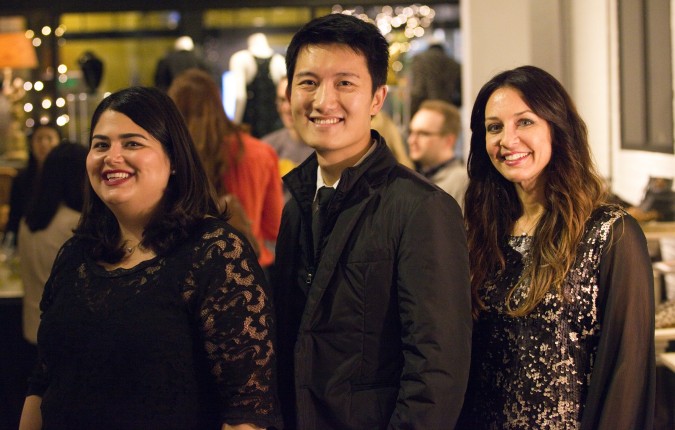
Kristen Slowe, Leo Chen and Kristen Philipkoski at Fara, Inc. launch party for Apple iPad app named Monogram. At La Boutique L'art et la mode, 414 Jackson Street, San Francisco, California USA, November 27, 2012.
Kan told me about his latest project, named Exec. Exec is an Apple iOS app that lets users hire an assistant for short term projects for a fixed rate currently of USD $25.00 per hour. An Exec assistant was stationed by the front door to La Boutique to make sure only guests on the list were admitted. I spoke with her for several minutes, and was impressed. I would use Exec if I needed an assistant for a project that Exec was suited for. One suggestion: When funds permit, buy the domain exec.com. The current url, iamexec.com, on quick viewing of the web browser address bar, reads as ‘lame exec’ because I saw the lower case i as an l. I had a good laugh about this, but I still recommend paying out the dollars to get the shorter url once it’s easily afforded. The url exec.com is currently up for sale, and has no developed site associated with it. Don’t wait too long, or the price will keep going up.
I also had a nice talk with the husband of Monogram co-founder Kristen Slowe. Kristen is Chief Creative Officer of Monogram. Her husband Christopher Slowe, is Chief Scientist at Hipmunk, which, according to their introductory video, ‘takes the agony out of travel search.’
Christopher and my father studied the same subject at the same university.
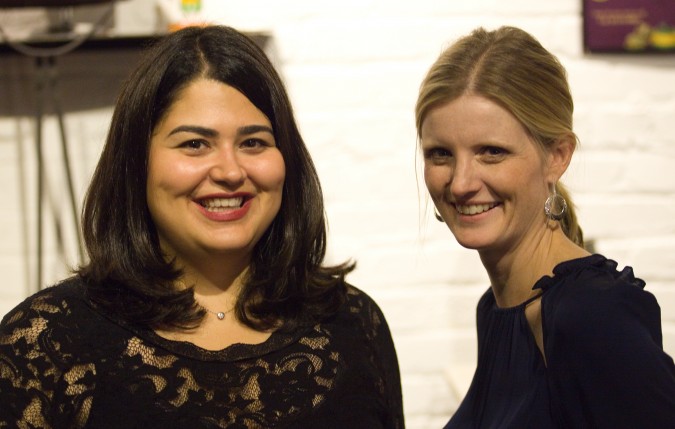
Kristen Slowe and Erin Flynn Hakansson at Monogram launch party, November 27, 2012, San Francisco, California USA
I got to talk with Jim England, a co-founder at Publik Demand. I met England at the same 500 Startups Demo Day where I met Chen. I absolutely love Publik Demand, a website that gives representation and power to consumers, so that they can insist that wrongs done by a company are addressed.
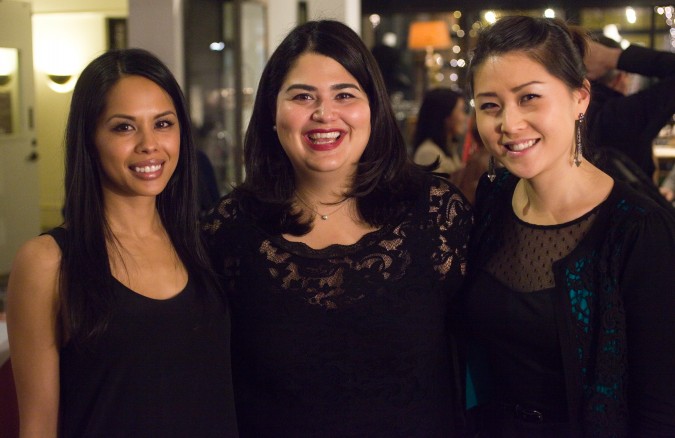
Lisa Garcia, Kristen Slowe and Sarah Choi from Monogram team at the Monogram launch party, November 27, 2012, San Francisco, California
I also got to talk with Cheryl Yeoh, co-founder and CEO of Reclip It, a website that brings together more than 200,000 online coupons & deals from many other coupon websites, for one stop access to money saving offers. I met Yeoh the same day I met England and Chen
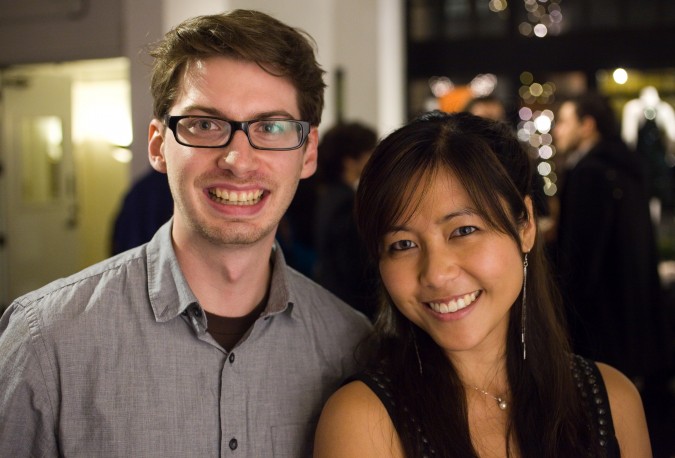
Jim England, co-founder of Publik Demand, and Cheryl Yeoh, CEO of ReclipIt, at Monogram app launch party, November 27, 2012.
I conclude with a photograph I love of Monogram co-founders Chen and Slowe that I took July 18, 2012 at the 500 Startups Demo Day, held at the headquarters of the publicly traded game company Zynga, at 699 8th Street, San Francisco, California USA.
I love Monogram, and that’s why I attended their launch party. I wish them the best of success. This is one of the few companies that truly counts on beautiful photographs for its success. Since I am an avid photographer, I connect with this company more than many.
AT&T CEO Randall Stephenson is interviewed September 6, 2012 by Rich Lyons, the Dean of the Haas School of Business at University of California Berkeley

Rich Lyons, Dean of the Haas School of Business at UC Berkeley interviews Randall Stephenson, the CEO and Chair off ATT, September 6, 2012. Photograph by Kevin Warnock.
On Thursday, September 6, 2012, I attended the Dean’s Speaker Series at the Haas School of Business at the University of California at Berkeley, in Berkeley, California USA.
This was the first Dean’s Speaker Series I have attended.
I have been aware of this series for years, but I assumed attendance was restricted to friends of the Dean, Rich Lyons, because of the name of the event.
I’ve met and spoken with the Dean about ten times over the years, I estimate, including when he was the Acting Dean when Dean Tom Campbell took a leave of absence to help then Governor Arnold Schwarzenegger manage the finances of the State of California.

Rich Lyons, Dean of the Haas School of Business at University of California Berkeley, asks Randall Stephenson a question, September 6, 2012. Photograph by Kevin Warnock.
A couple of weeks ago I was looking over the Haas website and marveled at the outstanding list of upcoming individuals the Dean will be interviewing on stage. There in front of me were the magic words — the events are open to members of the Haas ‘community.’ I was pretty sure I qualified, since I am a sponsor of one of the school’s premier events, the Berkeley Startup Competition, and have been every year since 2000. I inquired and I got a seat — I was and am thrilled.
The Dean’s guest for this event was Randall Stephenson, the Chief Executive Officer of AT&T, the largest telecommunications company in the United States.
I am an AT&T customer, both for my home’s broadband Internet connection and for my wireless Apple iPhone 3GS, which I bought soon after launch. I no longer have a wired phone. I like AT&T’s service — I get great reception and few dropped calls.
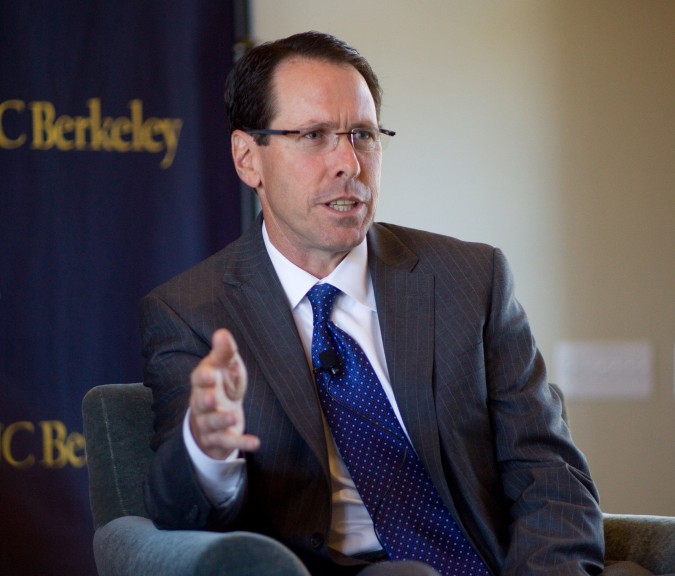
Randall Stephenson, Chair and CEO of AT&T, photographed by Kevin Warnock on September 6, 2012 at UC Berkeley
My regard for AT&T went up after listening to Stephenson speak for an hour. Stephenson was Chief Financial Officer and Chief Operating Officer prior to becoming Chair and CEO, among many roles.
He started at a job he called a ‘tape monkey’ at Southwest Bell Telephone in 1982 loading 19 inch diameter magnetic tapes of billing data onto tape drives. He did this work 12 hours a day — reading a video screen for instruction on which tape to load, finding the tape in storage, loading the tape and then pressing ‘Run.’
I did this same job, though not full time and not for 12 hours a day, when I worked at Cooley LLP. Thankfully I only had to do this role about two weeks a year, when the regular tape technician, Bill Calhoun, went on vacation.
Stephenson said he figured a way to rework his tape loading job to make it much more efficient and enjoyable, though he didn’t tell us the details of what he changed.

Rich Lyons, Dean of the Haas School of Business at University of California Berkeley, listens to Randall Stephenson answer a question, September 6, 2012. Photograph by Kevin Warnock.
During his introductory remarks, Rich Lyons said Stephenson worked in Mexico City as SBC’s Director of Finance.
At some point, Stephenson worked in Mexico for Carlos Slim, the iconic leader of Telmex. Stephenson did not explain how he came to work for Carlos Slim, who presumably was not an SBC employee at any point in his life.
Stephenson said Carlos Slim is ‘the most inherently brilliant individual that I’ve ever worked with.’
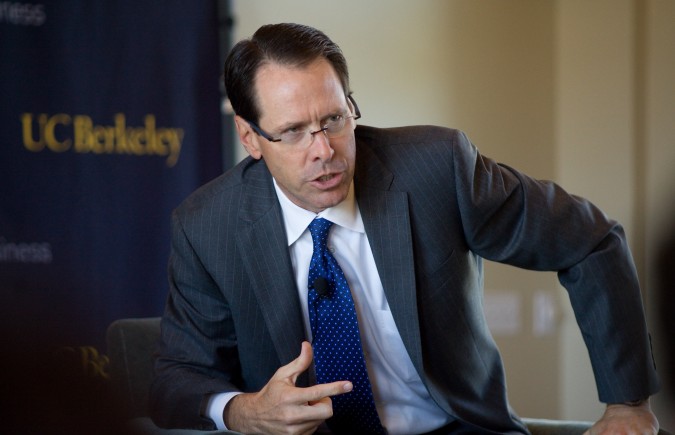
Randall Stephenson, CEO and Chair of AT&T, speaks at University of California at Berkeley, September 6, 2012. Photograph by Kevin Warnock.
Stephenson was in Mexico working for Slim in 1994 when there was an economic crisis that began December 19, 1994, when the Mexican government lifted all restraints on the Mexican Peso and let its value float. The Mexican currency lost 40% of its value in one day, Stephenson recalled.
Slim had 20,000 wireless subscribers in 1994, and thanks in part to the aggressive investments Slim made in the aftermath of the economic crisis of 1994, TelMex now has over 200 million wireless subscribers and Slim has made himself reportedly the wealthiest man in the world.
Stephenson took his job as CEO in June 2007 when ATT was a $100B annual revenue company with 300,000 employees, the same month that Apple launched its first iPhone. Stephenson invested heavily when the 2008 financial crisis came.
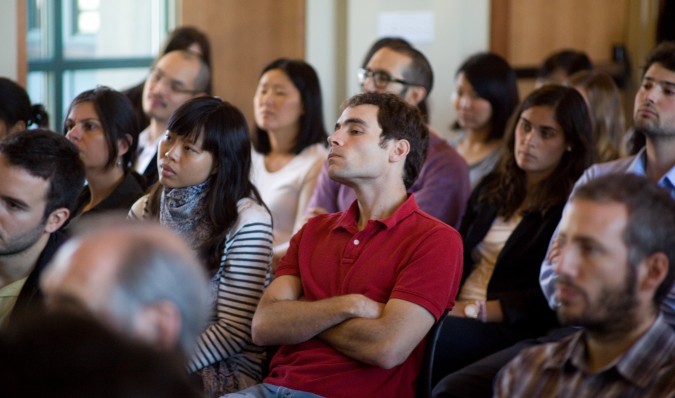
University of California Berkeley students listen to AT&T CEO and Chair Randall Stephenson speak, September 6, 2012
Stephenson said that 170,000 of AT&T’s employees actively participate in its TIP — The Innovation Pipeline — system conceived by the company’s CTO, a guy so tough to hire that it took ten years for Stephenson to do so. This system allows employees to propose ideas for the company to work on developing. People vote on the ideas and the best ones that float to the top are funded and pursued. In response to a question from a student in the audience, Stephenson said that apart from advertising the program to employees the company does little to promote participation. He said participation is quite good.
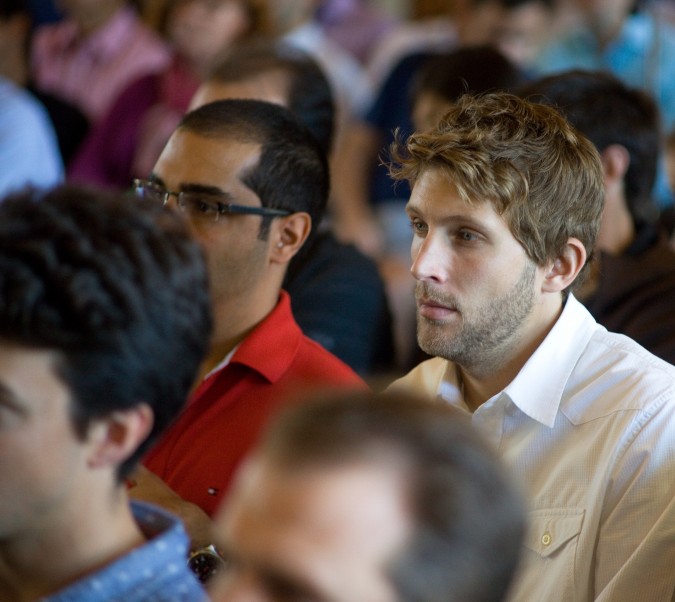
University of California Berkeley students listen to AT&T CEO and Chair Randall Stephenson speak, September 6, 2012
Stephenson and and his public relations person Larry (last name not mentioned) said they were so excited about a couple of their ‘tattooed up’ technologists in their Palo Alto, California research lab named the ‘Foundry’ that they put photographs of them in AT&T’s Annual Report. Stephenson divulged that competitors now are ‘coming after’ these programmers trying to hire them away from AT&T.

University of California Berkeley student asks AT&T CEO Randall Stephenson a question about AT&T's TIP suggestion system, September 6, 2012. Photograph by Kevin Warnock.
A student from the audience asked Stephenson to discuss wireless handset subsidies. Stephenson answered at length and concluded that the current system in the United States is overwhelmingly what customers want. He said AT&T performed studies where customers were asked if they would like to finance a phone via a separate finance contract, in exchange for markedly lower rates for service. Stephenson said customers did not like this proposal.
I think the survey respondents that answered this way are short sighted.
The way things operate in the United States, where one can buy a USD $700 iPhone for $200 because of the carrier subsidies, there is a perverse incentive to upgrade your phone exactly every two years. That is because contracts generally run for two years. If you keep a phone for three years, that final year you are paying much more than is warranted for service.
People should be encouraged to save money, not spend, so I admire the relatively new system reported by Stephenson to be the norm in Europe — phones are not subsidized and rates for service are [I hope] commensurately lower. Stephenson said phone sales dropped dramatically when this policy was implemented, but I say that is just what the world needs. People keep a home phone for decades. People keep televisions, stereos and other household appliances for years. Stephenson told me one-on-one after the event that fully 90% of his company’s customers upgrade their wireless phone every 14 months. Since contracts are two years long, 90% of its customers are paying early termination fees, which decline over time. That is a waste of the world’s resources, even in this day of a vibrant resale market for used mobile phones. I’m pretty sure a lot of people just throw their old mobile phones in a drawer, to benefit nobody. I understand mobile phones improve rapidly, and I do plan to get the latest iPhone when it’s available, having skipped the iPhone 4 and iPhone 4s. I just don’t approve of upgrading exceptionally frequently, which I consider 14 months to be.
I encourage AT&T and all carriers to offer unbundled rates for mobile service, as an option.
Rich Lyons is a good interviewer. The setting was photogenic — two handsome cushioned arm chairs on an elevated stage, with a small end table between the chairs. Lyons and Stephenson wore wireless lapel microphones. There was a backdrop behind the men that repeated the logos for UC Berkeley and the Haas School of Business, so the logos made it into every photograph of the people on stage. As a photographer, I applaud the Dean for creating such an inviting, warm and photogenic environment for his interviews. I look forward with enthusiasm to the next Dean’s Speaker Series interview, which I hope to be able to attend.
Former Haas Dean Dr. Laura D’Andrea Tyson is on the Board of Directors of AT&T, and presumably she helped Lyons recruit Stephenson to visit the Haas School. Tyson was Dean when I was a finalist in the Berkeley Business Plan Competition in 1999 with my company Hotpaper.
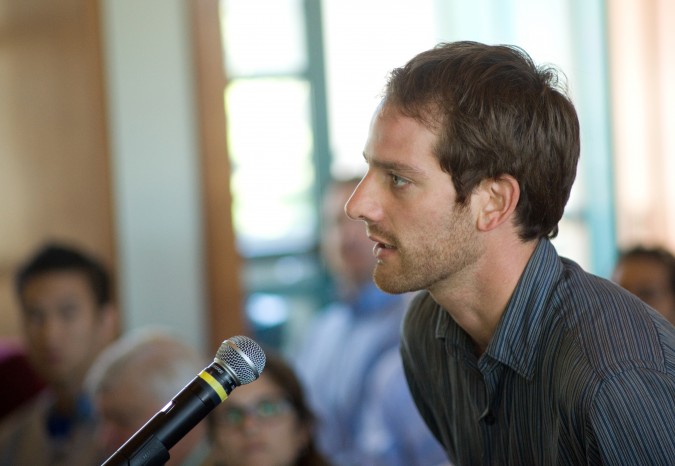
Student asks AT&T CEO and Chair Randall Stephenson a question about mobile handset subsidies, September 6, 2012, at University of California Berkeley
I took the photographs that accompany this blog post.
I used a Canon 5D Mark II camera with the following lenses: Canon 135mm soft-focus lens set to sharp, Canon 16-35mm L zoom lens. I upload pictures to this blog at maximum camera resolution at maximum image quality. Click on the photographs twice in delayed succession to see the full size images. If you would like to use these pictures, please send me a message. If the purpose is reasonable, I will allow usage. I enjoy having my pictures displayed elsewhere. I pursue photography only as a hobby, not as a profession.

At the end of his interview, Rich Lyons stands with ATT CEO and Chair Randall Stephenson at the Haas School of Business, September 6, 2012. Photograph by Kevin Warnock.
Finally, I have some advice for Berkeley students reading this post — introduce yourself to the speaker.
I don’t recall seeing any students introduce themselves to Stephenson. I did see a professor and a president of a good sized company say hello, but that’s it. Stephenson spent several minutes talking with me because there was nobody waiting after me to speak with him. The room had rapidly cleared out. The interview was during the lunch hour, so perhaps the students had to be in class immediately after. It’s rare for so prominent a CEO to speak to such a small group — there were about 140 students in the room by my quick count. I’m sure Stephenson won’t be back this academic year. Make a point of meeting all such prominent speakers. In my mind, Stephenson should have been surrounded by dozens of students trying to shake his hand. Stephenson didn’t appear to be in a rush to depart, and I left before he did.
Modify Watches retail launch party at Hangr 16 boutique in San Francisco, California USA, August 9, 2012
On Thursday, August 9, 2012 I attended the retail launch party for Modify Industries, Inc.
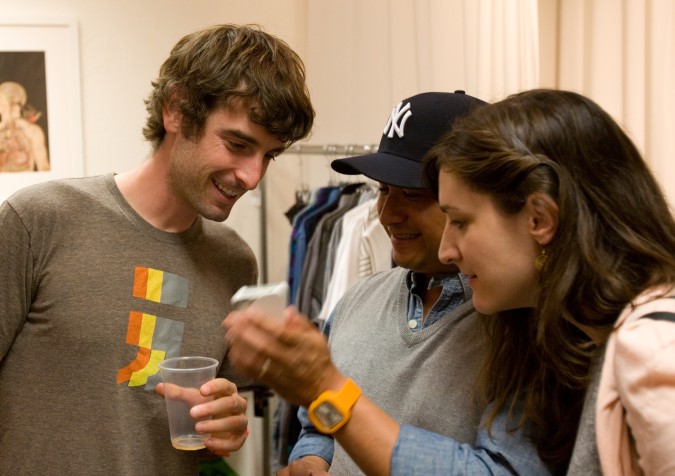
Aaron Schwartz, left, CEO of Modify Watches, checks out an Apple iPhone app August 9, 2012 at Hanger 16 at 3128 16th Street, San Francisco, California USA
Modify Industries is the company behind the colorful and fashionable silicone rubber Modify Watches brand watches that feature time pieces that without tools may be interchanged between bands. You can see people wearing Modify Watches in the top three photographs that illustrate this post. The watches come in two sizes. There are dozens of time pieces and dozens of straps (bands) to select from.
Modify Watches was a finalist competitor in the 2012 Berkeley Startup Competition at the University of California. That competition is very competitive, and it’s very difficult to become a finalist, as there are only eight per year, while most years more than 100 teams apply to compete.
I am friends with Modify CEO Aaron Schwartz.
Click here to see all my blog posts, past and future, that I have written about Modify Watches.
Modify has focused its attention on eCommerce sales and enterprise sales. It has achieved impressive success in both areas, selling to big companies including Google.
Now Modify is moving into retail by selling to boutique retailers.
One such boutique is Hangr 16 at 3128 16th Street in San Francisco, California USA, near Valencia Street. Hangr 16 carries the Modify line of products. The store’s energetic and charismatic buyer, Liddy Parlato, decided to sell Modify’s eye catching line after she opened an email targeted to her store from the company. Parlato told me she gets 30 pitches a day by email. Parlato’s store is spare and elegant, with a well curated selection. It’s not jammed with hundreds of product lines like many boutiques. Thus, Parlato’s decision to carry Modify’s products is a win for Schwartz and his team. Parlato is one of four owners of Hanger 16. She comes from a background in advertising, not retail.
While researching this blog post, I learned that Hangr 16 was voted the Best Clothing Store for Men by readers of the San Francisco Bay Guardian weekly newspaper. That makes the store’s decision to sell Modify Watches all the more special.
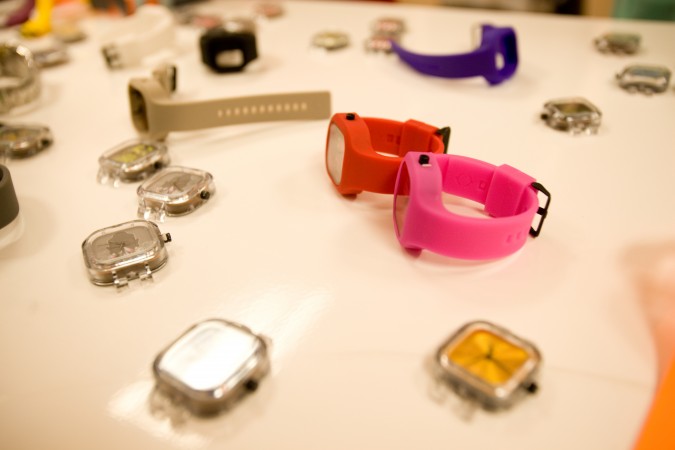
Modify Watches still life at Hanger 16 retail launch event August 9, 2012 at 3128 16th Street San Francisco, California USA
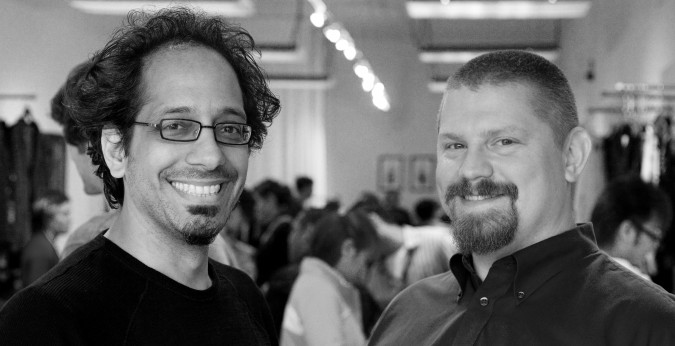
Abie Hadjitarkhani and Nathan Dintenfass, founders of Hotel Delta, at Modify Watches retail launch party, San Francisco, California USA, August 9, 2012
Abie Hadjitarkhani and Nathan Dintenfass attended the launch party. I know Dintenfass from the Haas School of Business at the University of California Berkeley. I met him while he was getting his Masters of Business Administration degree. I participate in many events at Haas to help the students and by extension The Lester Center for Entrepreneurship and Innovation.
Dintenfass and Hadjitarkhani run Hotel Delta, a boutique consultancy that helps entrepreneurs create great products.
Hotel Delta produces the Products are Hard conference.
Nathan Dintenfass is one of the smartest entrepreneurs I know. I have spent hours listening to him advise startups, and his wisdom is evident and deep.
Congratulations to Schwartz and his impressive team at Modify Industries. I predict great things to come.
I took the pictures that accompany this post. I uploaded them at full camera resolution of 21 megapixels. Click on them in delayed succession to see the full size versions, which are larger than your screen.
Legal disclosure — Schwartz let me borrow six of his company’s watches so that I may photograph them being worn by the female models I photograph. I pursue photography as a hobby, and do not charge for my work, so perhaps this disclosure is not legally required. To cover my bases, I am disclosing this loan. I proposed this arrangement, not Schwartz. I would have written this post even if Schwartz did not let me borrow any watches. I will return the watches to Schwartz once I photograph them with some additional models.
Annual Andrew Fluegelman Awards Gala Honoring Outstanding Students, Student-Athletes & Foster Parents, May 18, 2012
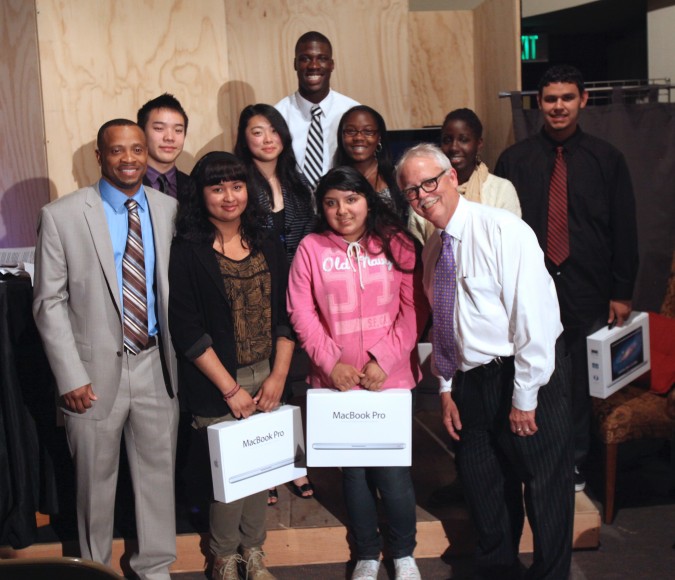
Winners of 2012 Andrew Fluegelman Foundation Fellowship Awards showing off their new Apple MacBook Pro laptop computers, May 18, 2012. Bruce Bouligny on left and David Bunnell in white shirt.
On Friday, May 18, 2012, the day of the Facebook Initial Public Offering of stock, I attended the annual Andrew Fluegelman Foundation Fellowship Awards Gala, held at the Linen Life Gallery at 770 East 14th Street, San Leandro, California USA. Here is the Facebook page for the Andrew Fluegelman Foundation. Bruce Bouligny is the Director of the Fluegelman Foundation.
I learned of this event the morning of the event, thanks to a Facebook status update from Harry McCracken, Editor-at-large at Time Magazine. McCracken encouraged his Facebook subscribers, of which I am one, to attend this event. McCracken also linked to a piece he wrote for Time entitled Remembering Andrew Fluegelman, a Quiet Giant of the PC Revolution that introduced me to Andrew Fluegelman, a man I had not previously heard of. Once I read McCracken’s piece on Fluegelman, I got a ticket for the Awards Gala and attended as a blogger. Amazingly, the tickets were free, although they did ask for a modest donation at the door, which I happily made.
Andrew Fluegelman disappeared in 1986, and it’s assumed he committed suicide by jumping from the Golden Gate Bridge. He was 42, and his body was never found.
I had only been at the Linen Life Gallery for mere minutes when my friend Stuart Sweetow came over to say hello. I recognized him but couldn’t place him, as I only see Sweetow at the Berkeley Entrepreneurs Forum at The Lester Center for Entrepreneurship and Innovation at the Haas School of Business at the University of California at Berkeley. He’s the videographer for the forums, and has been for some 15 years. I have had the privilege of appearing in one of Sweetow’s videos that he created for the Forum.
Sweetow absolutely made my evening.
How so? It turns out that Sweetow runs a business called Audio Visual Consultants. He’s been in business since 1983 — impressive. In 1986 he was hired by PC World, which Fluegelman co-founded with David Bunnell, to produce a video tribute to Andrew Fluegelman.
A few weeks ago, Sweetow was moving his company’s office and studio to new space and he stumbled upon the ancient video cassette he had produced decades earlier. He decided to call David Bunnell, the co-founder of the Andrew Fluegelman Foundation (and PC World Magazine), to ask if he wanted the tape. Bunnell was probably stunned to get Sweetow’s call. The copy PC World received decades ago had been lost. It was thought that it would never resurface. Thanks to Sweetow, the Foundation and presumably PC World has the video again, and it’s been posted to YouTube so a wider audience can view it.
What a heartwarming story. Here’s Sweetow’s video:
I asked Sweetow if I could blog about this story, and he said that I may.
Sweetow then pointed out that David Bunnell was standing near us. Sweetow offered to introduce me, and I accepted.
David Bunnell co-founded PC World Magazine with Andrew Fluegelman. I used to read PC World frequently. Before the Internet, such magazines were required reading for those interested in technology. You read such magazines the way we read websites like TechCrunch and Engadget today. I got to meet a publishing legend Friday night.
Happily, PC World is still in business, with a vibrant online presence in addition to the physical editions of the magazine.
I asked David Bunnell if I could photograph him, and not only did he agree, but volunteered to step outside into the still bright daylight so I could get a well lit portrait of him. Had he not volunteered, I would have directed him outside, as the light there was perfect. The pictures of Bunnell are at the bottom of this post.
I used my Canon 5D Mark II for these photographs, and I uploaded them at full 21 megapixel resolution. Click on the pictures to see them at full size.
Here is what David Bunnell wrote for the official paper program distributed at the event:
“Andrew Fluegelman (1942-1985)
During his brief life, Andrew made major contributions to the booming computer revolution. In addition to co-founding PC World and Macworld magazines, he wrote PC-Talk, the software program that for the first time made it possible for personal computers to exchange data over a phone line.
Believing that PC-Talk should be available to as many people as possible, Andrew came up with the novel idea of simply giving it away and asking people to send in a donation if they liked the program.
Andrew called this method of distributing software, “freeware.” Thousands of other programmers started making their software available this way, which helped the PC industry grow even faster.
Underlying Andrew’s work was his profound belief that personal computers have the power to transform anyone’s life. Whatever a person’s background and circumstance, if they had a computer their lives could be dramatically changed for the better.
With the help of some of Andrew’s other friends, I established the Andrew Fluegelman Foundation to keep his memory alive and to realize his vision that computers can make a dramatic difference.
Working with other nonprofit organizations, we identify outstanding high school seniors who have overcome the challenges of growing up in poor neighborhoods and who have been accepted into university, college or other advanced educational program. They also must demonstrate a desire to “give back” to their communities.
In Andrew’s name, we give these students a Macintosh laptop computer, printer and training in the use of Google applications, courtesy of Google.
So far, all the students who have won Fluegelman Fellowships have gone on to be successful in college. They arepot to us that owning their own Macintosh computers has been a huge part of that success.
I truly believe Andrew would have loved this program, and that his spirit is with us tonight.
–David Bunnell”
Fluegelman in 1982 created PC-Talk, the first dialup communications program for IBM Personal Computers and their clones. Back then, computers were connected via standard wired telephones directly to each other, not by going through central servers run by companies like AOL, Compuserve or Prodigy. Fluegelman distributed PC-Talk at no charge, and encouraged people to copy it and give it to friends. He made money by asking but not requiring that people mail him money via postal mail. He suggested donations of USD $25 and later more. That was a fair amount of money back then. I suspect it still works today, at least on Windows XP.
Fluegelman was the first Editor-in-Chief of PC World magazine. He interviewed Bill Gates in 1984, as shown in this picture from the Fluegelman Foundation’s Facebook page:

Andrew Fluegelman, on the far right, interviewing Bill Gates, standing, in 1984. Photographer unknown.
The Fluegelman Foundation honors Andrew Fluegelman’s memory by awarding Apple MacBook Pro computers to seven deserving high school seniors each year. Fluegelman believed that a computer could change a person’s life, so he would have approved of the work this foundation is doing.
This year Apple MacBooks were awarded to:
- Daniel Rodriguez – Castlemont High School
- Teresa Unique Cole – MetWest High School
- Andranee Nabors – Berkeley High School
- Cara He – Skyline High School
- Rocio Montes – Skyline High School
- Brian Lien – Skyline High School
David Bunnell and Bruce Bouligny took turns reading portions of the winning essays these winners submitted to compete for the laptops. The students were not given a chance at the microphone to say ‘thank you.’ I suspect this was the first time these students had been on stage outside of school. In future years, I suggest the organizers allow each student 60 seconds at the microphone to say thank you. They should be told of this opportunity in advance so they can prepare and practice their remarks. They will likely be nervous, but it should be a condition of winning that they say something. It will be a valuable learning experience to speak before strangers, and it’s one they won’t likely ever forget. The audience I am sure would welcome hearing from the students.
I tried hard to get permission to photograph the winners individually like I was able to photograph David Bunnell and Larry Magid, below. But I didn’t ask soon enough and the time simply ran out. I would have loved the chance to spend two minutes with each student properly photographing them. If I attend next year, I will prepare in advance with the organizers so that I can do this.
The Fluegelman Foundation also gives awards to an outstanding foster parent each year. I did not learn how this award is connected to Fluegelman, and there may be no overt connection. Whether there is or not isn’t important. The evening was an inspiring delight, and I am so glad that I attended.
Two foster parents spoke.
The first foster parent to speak was Tracy Beckham, who has 12 children. Eleven she and her husband adopted after doctors told her they would not be able to conceive and carry to term a biological child. We learned that their youngest child, the girl in the white dress below, is their biological child, and she was conceived naturally with no assistance from the fertility industry. Beckham told us how doctors at first thought she was sick, but eventually concluded she was pregnant. What a happy surprise.

Tracy Beckham with her family plus a few others, May 18, 2012 at Andrew Fluegelman Fellowship Awards Gala. Photo by Kevin Warnock.
Beckham’s 6’6″ son Dorial Green-Beckham, the tallest in the two shots immediately above and below, is already famous, with his own entry in WikiPediA, I learned. The pictures I took of him are likely to get this blog some significant traffic. Thank you Dorial and thank you to his mother Tracy, who gave me permission.
Dorial is a famous high school football player. According to The Columbian Missourian newspaper, Dorian was the most recruited high school football player in the United States in 2012. Here’s a long piece that details how intense this process was.
Dorial signed with the Missouri Mizzou Tigers, after a courtship that lasted years. I had no idea before today that even happened. I don’t follow football, and I only occasionally watch the Super Bowl.
I had never heard of Dorial before this event. I am glad that I met him, and he was gracious and patient as I set up the pictures you see here. I gave him posing directions just like I give the female models I photograph. I wonder what he thought of me given that he’s probably been photographed by hundreds and hundreds of photographers to date.
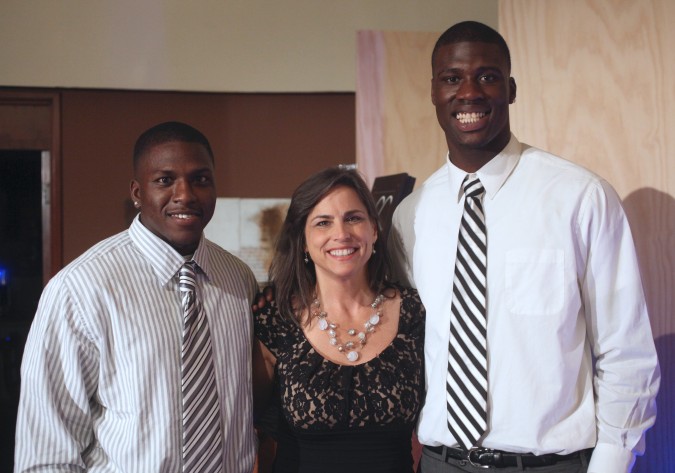
Tracy Beckham with 2 of her 12 children including Dorial Green-Beckham on the right. May 18, 2012 in San Leandro, California. Photo by Kevin Warnock.
Have a look at this YouTube video that shows Dorial breaking the United States national receiving record for high school football.
Here’s a clip of Dorial catching a 79 yard pass with one hand during the 2012 Army All American Game. Looks impressive to me:
Dorial Green-Beckham was awarded the first National Fellowship awarded by the Fluegelman Foundation, and Dorian was given an opportunity to speak to the audience, which he accepted.
The second foster parent to speak was Athaline Burns, shown in the photograph below holding her award plaque for East Bay Foster Parent of the Year.
Burns told the crowd she provided care to about 100 foster children that lived in her home over the years. This is an astonishing and important contribution to society. Burns kept her remarks short, so I don’t have any stories to relate about her remarkable life. I didn’t have the opportunity to talk with her after the event, which I regret. I would like to interview her for this blog at some point, and meet her family to hear about their experiences first hand. I have at times considered becoming a foster parent, so I have more than a casual interest in this subject.
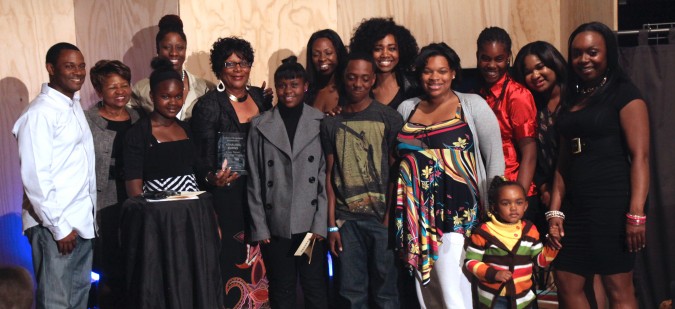
Athaline Burns, holding award plaque, shown with her family. Burns is East Bay Foster Parent of the Year. May 18, 2012 in San Leandro, California. Photograph by Kevin Warnock.
Here is the portrait that I took of David Bunnell and Larry Magid together:
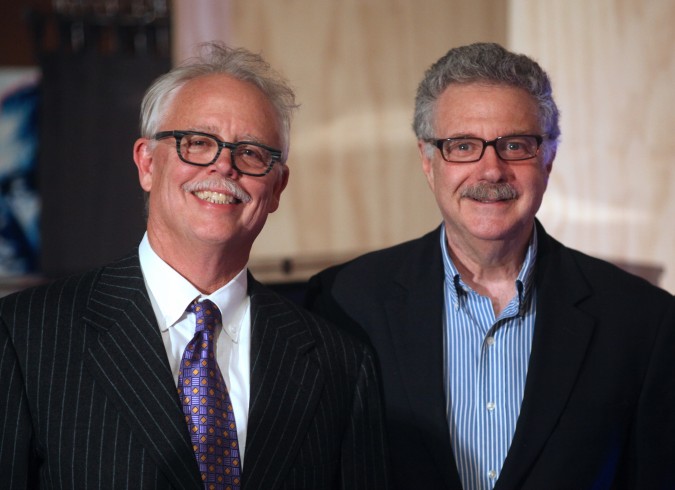
David Bunnell and Larry Magid, May 18, 2012 at Andrew Fluegelman Foundation Fellowship Awards Gala in San Leandro, California. Photo by Kevin Warnock.
Bunnell and Magid provided commentary at the start of the event about the storied life of Andrew Fluegelman. I got the distinct impression that both Bunnell and Magid are elder statesmen in the technology industry, so I am so grateful that I got to photograph them together and separately, and that the results were so pleasing. Magid asked if he could use the results, and I happily told him that he may. Of course, Bunnell may as well, as well as all the others that I photographed. I am very flattered when I encounter my photographs around the web and on other peoples’ Facebook pages. Twenty four of my Facebook friends are also friends with Magid.
Larry Magid is Co-Director of ConnectSafely, a non-profit. Magid provided Gala attendees with free copies of the book A Parent’s Guide to Facebook (also published in Arabic). I have a copy, and from reading part of it I can say it’s well written and likely to be very valuable to parents. I’ve never seen such a lushly produced guide to safely using potentially a potentially dangerous site like Facebook. I plan to read the entire book. Here’s an abstract of what ConnectSafely is about, from the group’s website:
“ConnectSafely is for parents, teens, educators, advocates – everyone engaged in and interested in the impact of the social Web. The user-driven, all-media, multi-platform, fixed and mobile social Web is a big part of young people’s lives, and this is the central space – linked to from social networks across the Web – for learning about safe, civil use of Web 2.0 together. Our forum is also designed to give teens and parents a voice in the public discussion about youth online safety begun back in the ’90s. ConnectSafely also has all kinds of social-media safety tips for teens and parents, the latest youth-tech news, and many other resources.
ConnectSafely.org is a project of Tech Parenting Group, a 501(c)3 nonprofit organization based in Palo Alto, Calif., and Salt Lake City, Utah. The forum is co-directed by Larry Magid of SafeKids.com and Anne Collier of NetFamilyNews.org, co-authors of MySpace Unraveled: What It Is and How to Use It Safely. (Peachpit Press, Berkeley, Calif., July 2006).”
Larry Magid is also the on-air technology analyst for CBS. Magid has over 62,000 subscribers on Facebook.
Here is the portrait that I took of David Bunnell:
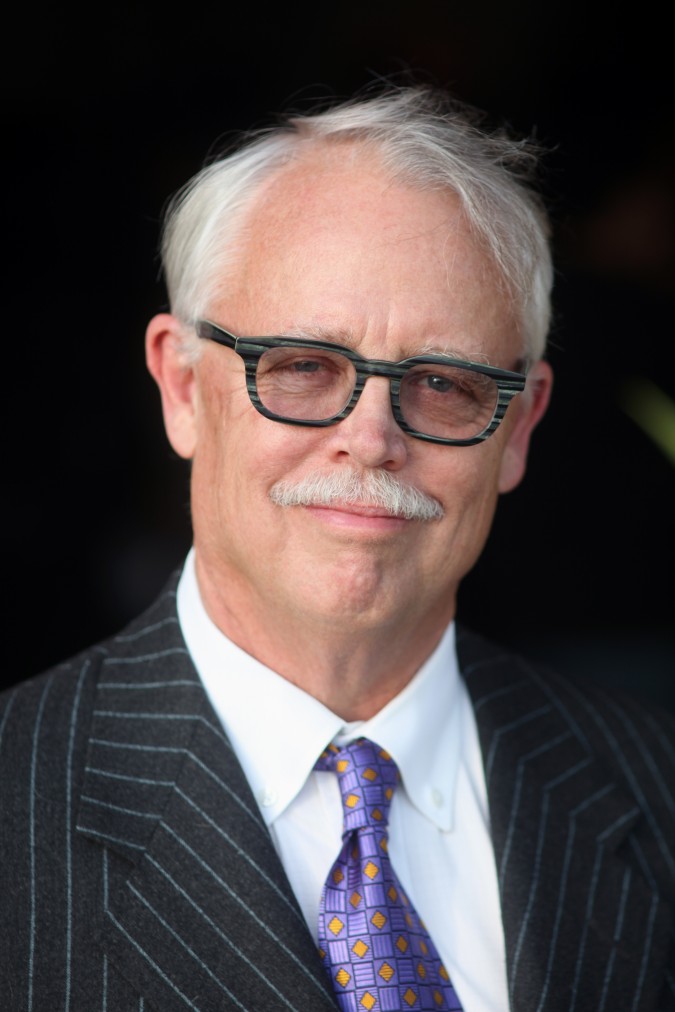
David Bunnell, co-founder of Andrew Fluegelman Foundation, May 18, 2012. Photographed by Kevin Warnock.
Here is the portrait that I took of Larry Magid:

Larry Magid, on-air technology analyst for CBS, photographed May 18, 2012 at the Andrew Fluegelman Foundation Fellowship Awards Gala. Photo by Kevin Warnock.
Here is a photograph of the reception prior to the awards ceremony. The food and drink were outstanding, thanks to B Restaurant and Bar, Trader Joe’s, Markham Vineyards, Carl Talaue Catering, RSVP Catering and T-Rex BBQ.
The Skyline Jazz Band, made of up musicians from Skyline High School, played during the reception. The band’s director is Vincent Tolliver. The musicians are:
- Olivia Ports – Drums
- Ella Pearson – Piano
- David McMillan – Guitar
- Zach Seidl – Bass
- Jeff Seidl – Trombone
- Jeramy Kaetzel – Trumpet
- Andrew Wong-Rolle – Alto Saxiphone
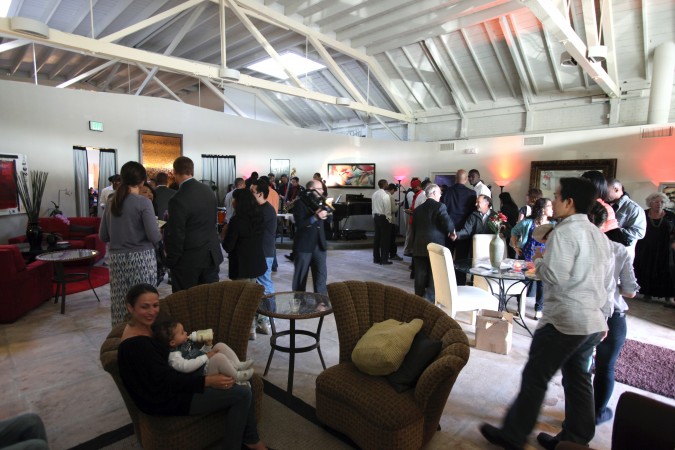
Reception at 2012 Andrew Fluegelman Foundation Awards Gala in San Leandro, California, May 18, 2012. That's Stuart Sweetow in the center holding the video camera.
Charleston Pierce was the Master of Ceremony. I found him vibrant, charismatic and engaging. He said he’s a graduate of San Francisco School of the Arts, or SOTA. This school is located in the same building where I went to high school. That school, J. Eugene McAteer High School, was dissolved in 2002 due to its being atrocious, which I can personally confirm.
SOTA seems to be churning out winners, like Devon Ivie, Havel Weidner and Cristina Rey, all of whom I met in February, 2012 at the San Francisco Mock Trials citywide finals. They were on the student team representing SOTA, which this year competed with Lowell High School, generally thought to be the best public high school in San Francisco. SOTA lost to Lowell this year, but has won over Lowell multiple times in past years. The students I met in February are very polished and impressive, and I predict they will go far in life, unlike most of my McAteer classmates, I am sad to report.
I got to shake Pierce’s hand, but sadly didn’t get to interview him. He’s in the entertainment industry, and I bet he’s somebody my readers would love to learn more about. If he’s reading this, I invite him to contact me to schedule an interview.
Congratulations to all the winners at the 2012 Andrew Fluegelman Foundation Fellowship Awards. To the student winners, I say study hard in college, drink alcohol very moderately or not at all, decline all illegal substances and activities, keep in touch with your professors long after you graduate, and start building and nurturing your personal brand right now, by blogging and Tweeting thoughtfully, articulately and responsibly.
When you graduate, future employers will then have four years (decline the five year program!!!) of your posts to read to get a sense of who you are and why they should hire you. You’ll be far ahead of most of your peers, even your peers that might have better academic credentials than you have earned. In life it’s not just grades, but your character, passion and drive that will advance you past your peers. You can start today with WordPress and your shiny new Macbooks. Good luck, and drop me a line once a year to let me know how your MacBook enhanced lives are going. I will write about you here if you take me up on this.
College will be over in two snaps of your fingers, so relish it, embrace it and blog about it! Have fun.
———-
May 21, 2012 – I added a photo credit to the caption under photograph of Stuart Sweetow, which was taken by Rufus Diamant.


